Displaying items by tag: Prominence
Glossary of Colorado Mountain Climbing Terms
A Glossary of Colorado Climbing and Peakbagging Terms
Inclusion criteria for summits on 100summits.com is somewhat different than other lists on the web. I realize that there is no accepted standard for defining a summit, in fact, Wikipedia suggests that "there is no universally-accepted definition of a mountain. Elevation, volume, relief, steepness, spacing and continuity has been used as criteria for defining a mountain." The Oxford English dictionary defines a mountain as "a natural elevation of the earth surface rising more or less abruptly from the surrounding level and attaining an altitude which, relatively to the adjacent elevation, is impressive or notable." Many sites (Vulgarian Ramblers, ListsofJohn, etc.) use the rule that the summit must have 300' of topographical prominence in order to be considered a mountain. While this metric is very good at distinguishing summits from false summits, it fails to recognize summits that are clearly summit-worthy, or have other features that would lure a person to want to climb or hike to the top of it. Many names of summits are found on the USGS maps. Those summits that are not found on USGS maps are either provided with nicknames given by local mountaineers, or they are designated by the prefix "UN" followed by the elevation of the summit.
Elevation is simply the height of the summit above sea level, in feet or meters. All data shown in the table is in feet; however, the elevation for each summit in meters can be found in the details page of each summit. Elevations are generally shown on each USGS 7.5 minute quadrangle for each summit. When elevations are not shown on the map, they are interpolated by looking at the closest contour line to the summit.
A summit in Colorado is defined as ranked if it rises at least 300' above saddles to higher summits (also known as topographical prominence). Summits in Colorado have been ranked this way for many years, and the 300' rule has been widely accepted by the mountaineering community as a very effective and arbitrary way to rank Colorado's summits. An "S" designation or "Soft Rank" means the summit could qualify as a ranked summit if extrapolated elevations were not used for the summit and/or interpolated elevations were not used to determine the elevation of the Prominence Saddle. When summits have the same elevation, ranking is determined in the following order: (1) Elevation, (2) Prominence, (3) Isolation, and lastly (4) alphabetically. A green checkmark indicates that the summit is ranked, while a red "X" indicates that the summit is not ranked.
The Prominence of a summit is its rise above the highest saddle connecting the summit to higher ground, otherwise known as the Prominence Saddle. In other words, the Prominence of a summit is it's height above the lowest contour line encircling it and no higher summit. Prominence is the elevation of the summit minus the elevation of the Prominence Saddle. Given elevations in a saddle are used, but only if they represent the low point of the saddle. Many climbers rate mountains solely based on its Prominence, rather than its elevation. If you personally feel that Prominence is the most important feature of a summit, you can filter the summit table to show the most prominent peaks in Colorado. On the summit table, Prominence is shown in feet; however, the detailed view of the summit also shows the Promience in meters. Wikipedia.org provides this great diagram, visually explaining Prominence:
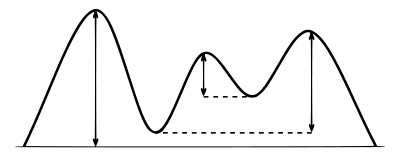
Vertical arrows show the Prominence of three peaks on an island. A dotted horizontal line links each peak (except the highest) to its Prominence Saddle.
The Promience Saddle is the low point of the highest connecting ridge to an elevation greater than the summit's maximum elevation. When multiple saddles are present but not on the same connecting ridge, the Prominence Saddle is selected by determining which saddle has the shortest distance to a line parent.
Spire Measure or Omnidirectional relief and steepness (ORS) is an absolutely brilliant concept that was developed jointly by David Metzler and Edward Earl. David Metzler graciously and laboriously provided all of the ORS data for every single summit in the 100summits.com database. ORS is a purely objective summit measure which takes into account how high the peak rises above local terrain, and how steeply. Since it is a local measure it does not take absolute elevation into account, only the relative height of the summit above its surroundings. So for example a lot of the Colorado Fourteeners get low ratings, since many of them are not very steep and rise from high bases. Also, it is an omnidirectional measure, so it averages out how steep a peak is in all directions. Hence something like El Capitan in California gets a pretty decent rating, but not as much as if it were a spire which was sheer in all directions. Hence the old name "spire measure"; while something does not have to look like a spire to get a decent spire measure, the more a peak is shaped like a big, steep pointy spire, the higher its spire measure will be. However ORS measures any landscape feature, not just spires; hence the name ORS. Learn more about the theory behind the ORS measurement.
ORS thus roughly measures the visual "impressiveness" of a summit, since peaks which rise high and steeply above their surroundings tend to be the most visually impressive. ORS also acts as a very rough measure of how difficult a peak is to climb, since it factors in steepness and height. However there are many other factors which determine how impressive a peak looks (a subjective notion, after all) and how hard a peak is to climb. It is important that ORS is not claimed to match any particular person's notion of impressiveness or climbing desirability.
It should also be noted that the ORS data for summits on 100summits.com does not factor in the fact that a summit could very well be a sub-peak of another summit, which can significantly reduce the ORS score of a summit. In fact, David Metzler has created another measurement that factors in the degree of independence a summit has from a larger, more impressive summit that it is adjacent to. This measurement is called Reduced Omnidirectional relief and steepness (RORS). Roughly, this measurement takes the spire measure of the summit in question and subtracts off a piece for each nearby better peak, based on how close together they are.
Lastly, it should also be noted that oftentimes the best ORS point is not a peak (i.e. it has little or no prominence). Hence making a peak list using prominence as a cutoff and then ranking the resulting list using ORS can be misleading, as it can totally miss some of the best features. An example of this is the Black Canyon of the Gunnison. This issue comes up frequently for a fair number of summits, where the best spot to measure ORS is not exactly at the true summit. For example, Longs Peak would score much higher in ORS if the measurement were taken closer to the steepest face as opposed to the actual summit. In those cases the true summit value is an underestimate of the quality of the peak
The Class of a summit refers to its subjective rating on the Yosemite Decimal System (YDS). A summit's Class is a measure of the difficulty of a peak in terms of climbing skills required, without regard to duration of the climb or the duration of the difficulty. The Class listed indicates the easiest ascent possible for the particular summit. By adding the summit as one you have climbed, you can designate your own Class rating based on the route you used to reach the summit. It should also be noted that a summit's Class is based by the hardest move on the route taken. For example, if a summit is very easy except for the summit block, where there is a 5.8 move, the route would be rated 5.8. The specific classes are defined by Wikipedia as follows:
- Class 1: Walking with a low chance of injury.
- Class 2: Simple scrambling, with the possibility of occasional use of the hands. Little potential danger is encountered.
- Class 3: Scrambling with increased exposure. A rope can be carried but is usually not required. Falls are not always fatal.
- Class 4: Simple climbing, with exposure. A rope is often used. Natural protection can be easily found. Falls may well be fatal.
- Class 5: Technical free climbing involving rope, belaying, and other protection hardware for safety. Un-roped falls can result in severe injury or death.
Class 5 is subdivided even further, ranging from 5.0 to 5.13.
In Mountaineering, Freedom of the Hills, author Ed Peters explains the subdivisions of class 5:
"The experienced climber, having accomplished or attempted free climbs of varying degrees of difficulty in the YDS class 5 range, gains an understanding of the level of difficulty involved. To the beginner, however, these ratings are simply a set of numbers, understandably, easy if rated 5.0 and impossible if rated 5.13. To provide a slightly better understanding within the class for the beginner the following tongue-in-cheek description is provided:
- 5.0 to 5.4: There are two hand- and two footholds for every move; the holds become progressively smaller as the number increases.
- 5.5 to 5.6: The two hand- and two footholds are there, obvious to the experienced, but not necessarily so to the beginner.
- 5.7: The move is missing one hand- or foothold.
- 5.8: The move is missing two holds of the four, or missing only one but is very strenuous.
- 5.9: The move has only one reasonable hold which may be for either a foot or a hand.
- 5.10: No hand- or footholds. The choices are to pretend a hold is there, pray a lot, or go home.
- 5.11: After thorough inspection you conclude this move is obviously impossible; however, occasionally someone actually accomplishes it. Since there is nothing for a handhold, grab it with both hands.
- 5.12: The surface is as smooth as glass and vertical. No one has really ever made this move, although a few claim they have.
- 5.13: This is identical to 5.12 except it is located under overhanging rock.
RJ Secor defines the classes bluntly:
- Class 1: you fall, you're stupid.
- Class 2: you fall, you break your arm.
- Class 3: you fall, you break your leg.
- Class 4: you fall, you are almost dead (i.e., you can't breath and move your arms, legs, and head).
- Class 5: you fall, you are dead.
Before one can fully understand Interpolation, it is helpful to understand how topographical maps graphically represent data through the use of contour lines. A contour line is a line that connects points of equal elevation. The contour line traces the outline of the terrain at evenly spaced elevations. These are determined by the contour interval. The contour interval is found below the map scale. In Colorado, the 7.5 minute USGS Quadrangles have 40' contour intervals. That means that every time you go up to another line the elevation increases by 40 feet and every time you go down a line the elevation decreases by 40 feet. Notice how the contour lines define the shape of the mountain. The lines are closer together where it is steeper. The spacing between the lines decreases as the slope of the mountain decreases.
Interpolation is a calculation of the mean of the maximum and minumum possible elevations within a contour interval. For example, a summit without a listed elevation on a 40' contour map with a highest contour of 12400' has elevation possibilities between 12400' and 12440' (12440' would be the next contour if one were present). The mean of these is 12420'. Sometimes field observation (actual in-person visualization) will reveal a higher summit location than maps indicate. In these cases, interpolation may be performed to average the spot elevation and the next higher contour rather than between contours. When a summit does not have an elevation on the USGS map, the summit elevation is calculated by extrapolating above the summit’s highest closed contour by half the contour interval.
Kit Carson Mountain, Challenger Point, Columbia Point, and "Kitty Kat Carson" - An Elevated Playground
Kit Carson Mountain is a very prominent mountain located in the Sangre de Cristo Range. The area surrounding Kit Carson Mountain is both rugged and pristine, with views of amazing peaks such as Crestone Needle and Crestone Peak in abundance. The hike to Kit Carson Mountain by way of the Willow Creek trailhead is nothing short of astounding, with breathtaking vistas available the whole way up. To put it lightly, this is one of the best hikes in Colorado, bar none.
Here are some meaningful statistics from my adventure up these amazing mountains:
Challenger Point – 14,081 ft – ranked 34th highest in Colorado
Kit Carson Peak – 14,165 ft – ranked 23rd highest in Colorado
Columbia Point – 13,980 ft – ranked 56th highest in Colorado
“Kitty Kat Carson” – 13,980 ft – unranked
Total distance traveled: Approximately 15 miles
Total elevation gain: 6,500 ft.
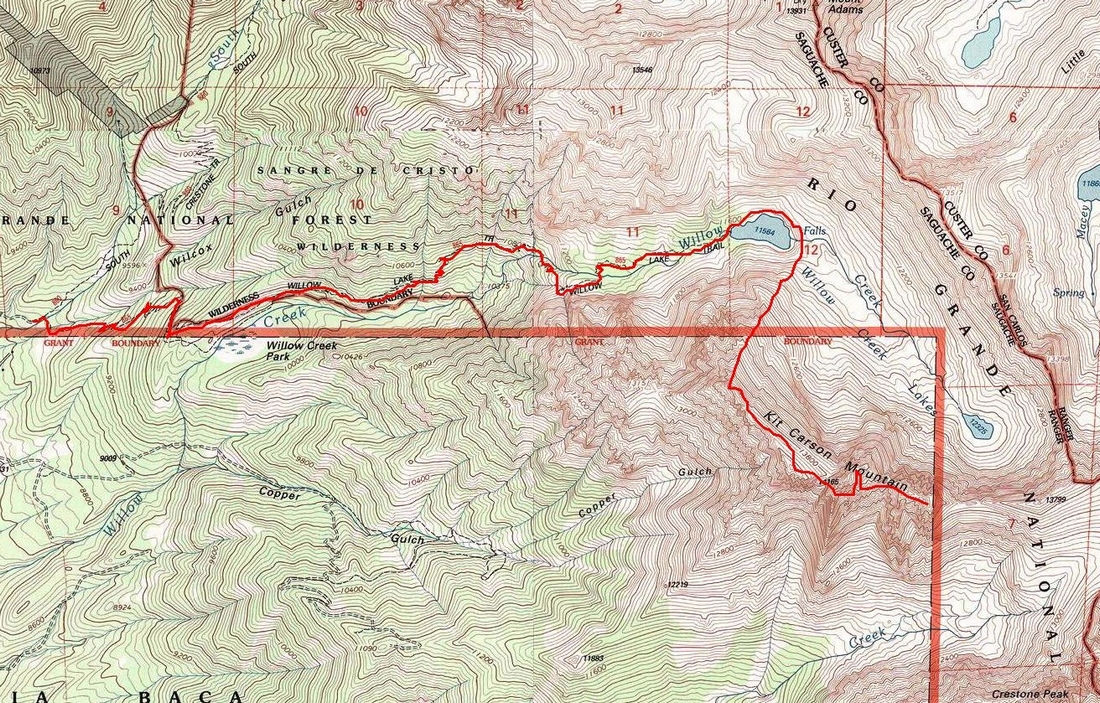
By now you might be wondering what makes a mountain ranked versus unranked. This is a fairly controversial topic in the climbing community. Basically, there is only one factor to consider when determining if a mountain should be "ranked" and that is prominence. The prominence of a peak is the height of the peak’s summit above the lowest contour line encircling it and no higher summit. Prominence is interesting to some mountaineers because it is an objective measurement that is strongly correlated with the subjective significance of a summit (and how difficult it is to climb). Peaks with low prominences are either subsidiary tops of some higher summit or relatively insignificant independent summits. Peaks with high prominences tend to be the highest points around and are likely to have extraordinary views. In the case of Colorado mountains, most mountaineers use a cutoff of 300 ft / 91 m to determine whether or not a mountain is ranked or not. So using “Kitty Kat Carson” above as an example, since there’s only 80 ft in elevation drop between itself and Columbia Point, it is not ranked. Alternatively, since there is 360 ft in elevation drop between Columbia Point and Kit Carson Peak, it is ranked.
I picked up my friend Terry from his condo at 5 AM on Friday and departed for the quaint town of Crestone. We arrived at the Willow Creek Trailhead at about 9 AM. There were several vehicles at the trailhead, which was kind of surprising given that it was still early on a weekday. This was going to be our third backpacking trek in as many weeks. This week I was able to get my pack down to 45 pounds, thanks in part to some lightweight food my mom graciously provided to me the previous day. We began our hike up the trail, which was well travelled. About 5 minutes into our hike, a gentleman with a long gray beard was coming down the trail and was very friendly to us, warning us of electrical storms. I commented to Terry that this was not my first rodeo and that the man reminded me of Jesus. I was hoping that his presence was not a sign of things to come… bearded man looking like Jesus appears out of nowhere and warns us of lightning… The trail was such a nice change from last week since it was actually easy to follow and was clearly maintained and free of vegetation and confusing side trails. The trail makes many large switchbacks up a gradual slope and then at the top of this slope it drops you right next to a huge meadow, accompanied by great views of part of Challenger Point.
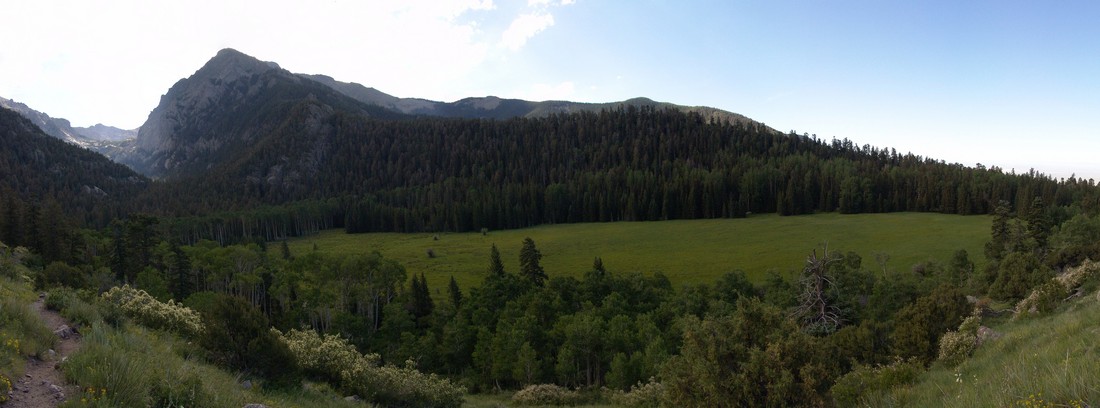
After awhile, the trail brought us closer and closer to Challenger’s headwall.
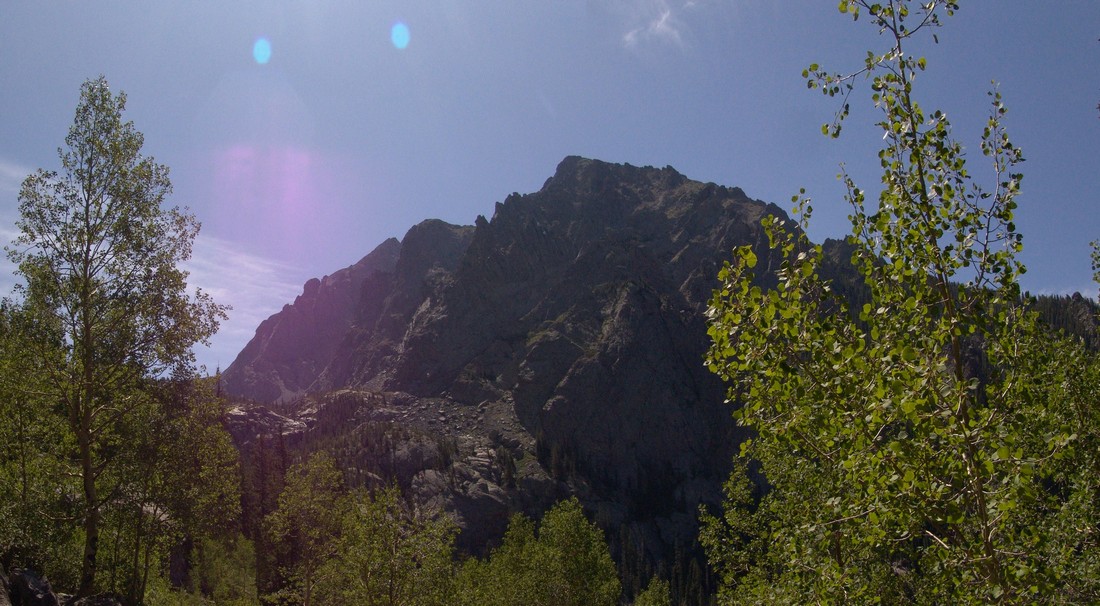
Shortly thereafter, the trail begins a long series of shorter switchbacks leading to the north and east until a large waterfall is exposed at the base of the headwall.
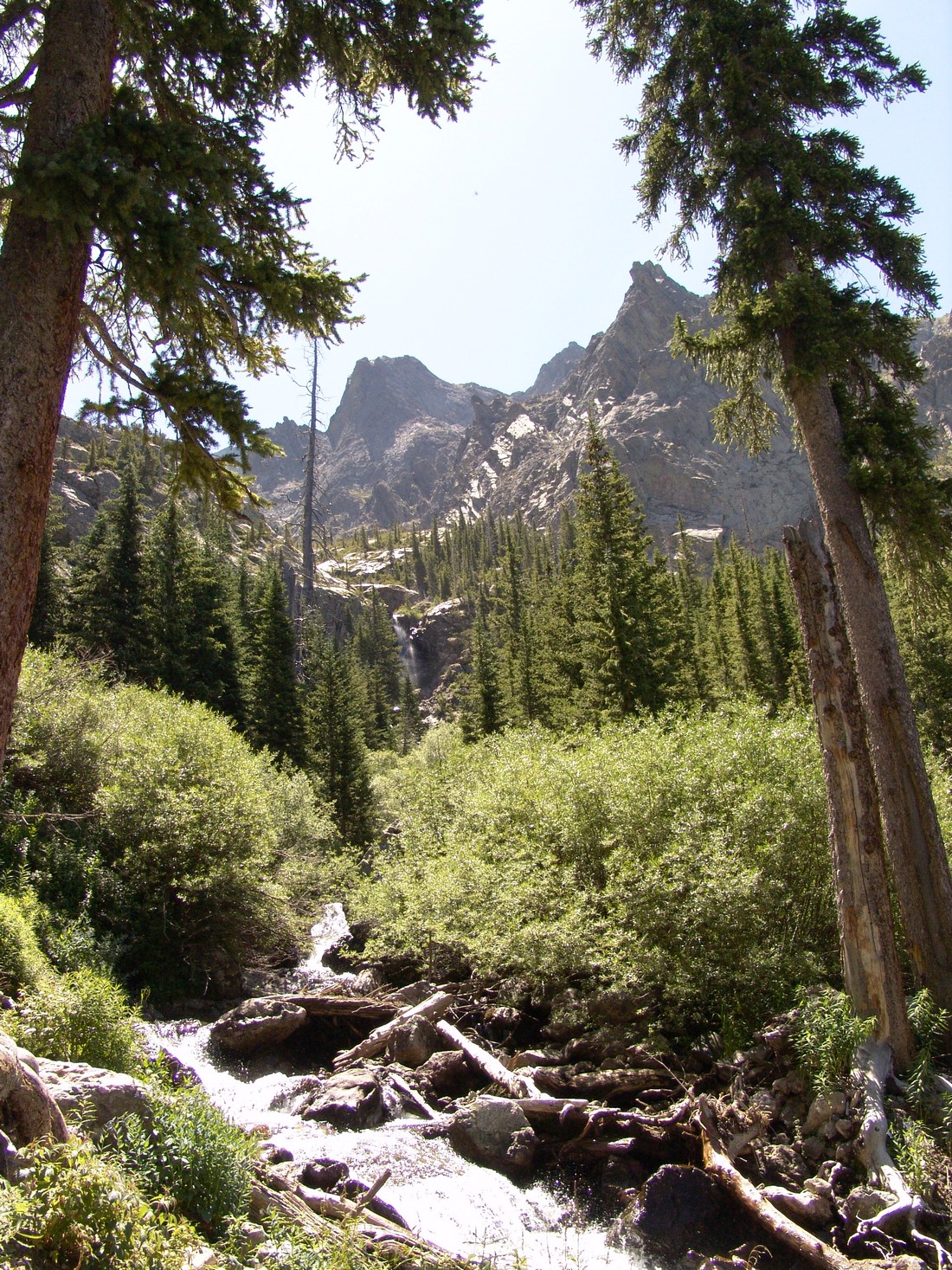
After gaining the headwall and hiking further up the trail, we were right at the base of Willow Lake. Being that we were in a Wilderness area, camping was restricted to areas no closer than 300 ft of the lake. One of the very first campsites we encountered had some Big Horn sheep grazing at it.

The sheep quickly scattered up the valley towards the lake. 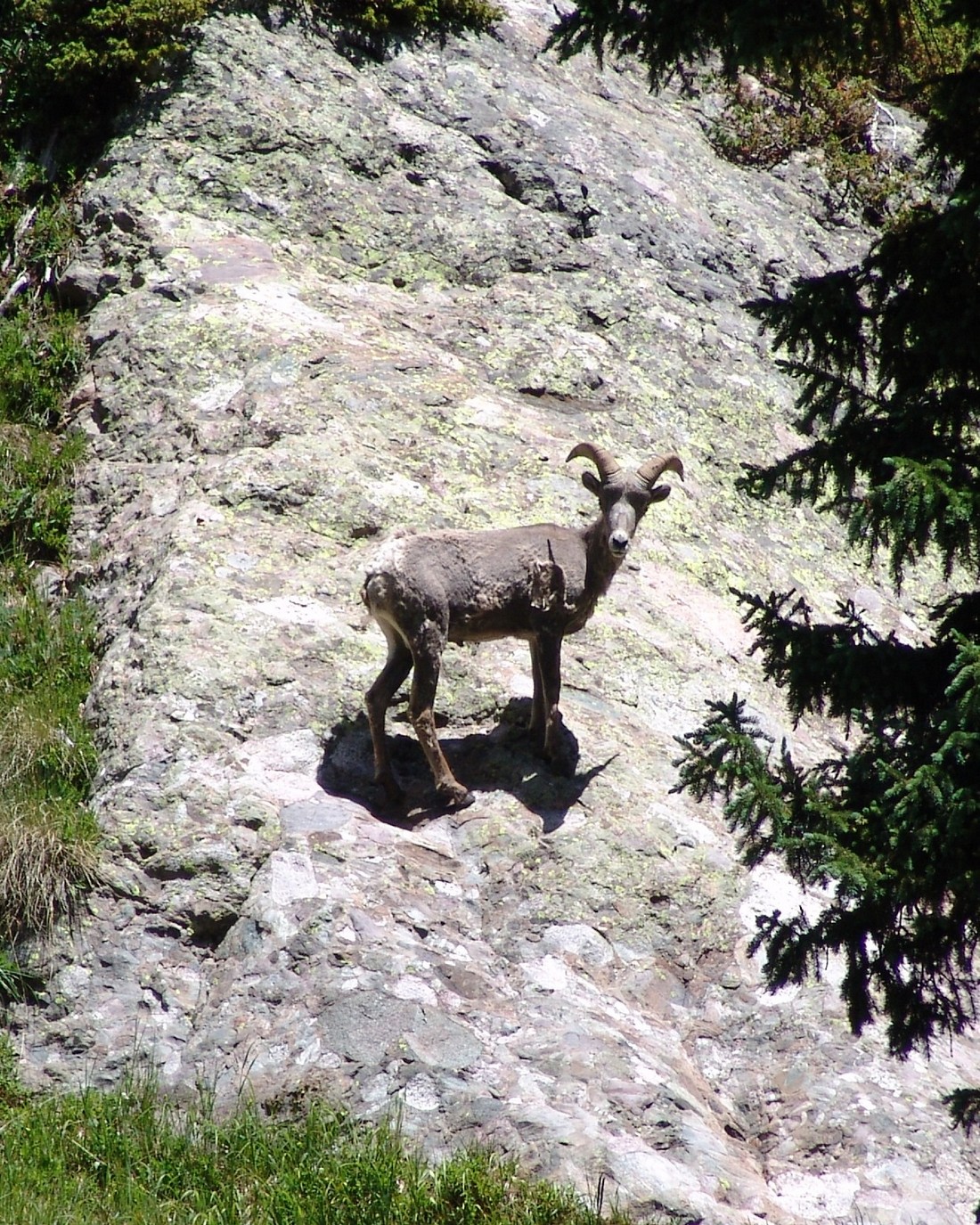
We kept going on the trail and found a really wonderful campsite left of the trail nestled in some trees. The funny thing was that the sheep were hanging out in this campsite. I was able to take several pictures of the sheep after we were able to claim the campsite as our own. This was one of the cooler things that has happened to me this year because one of my lifelong goals has been to see Bighorn sheep up close in the wild.
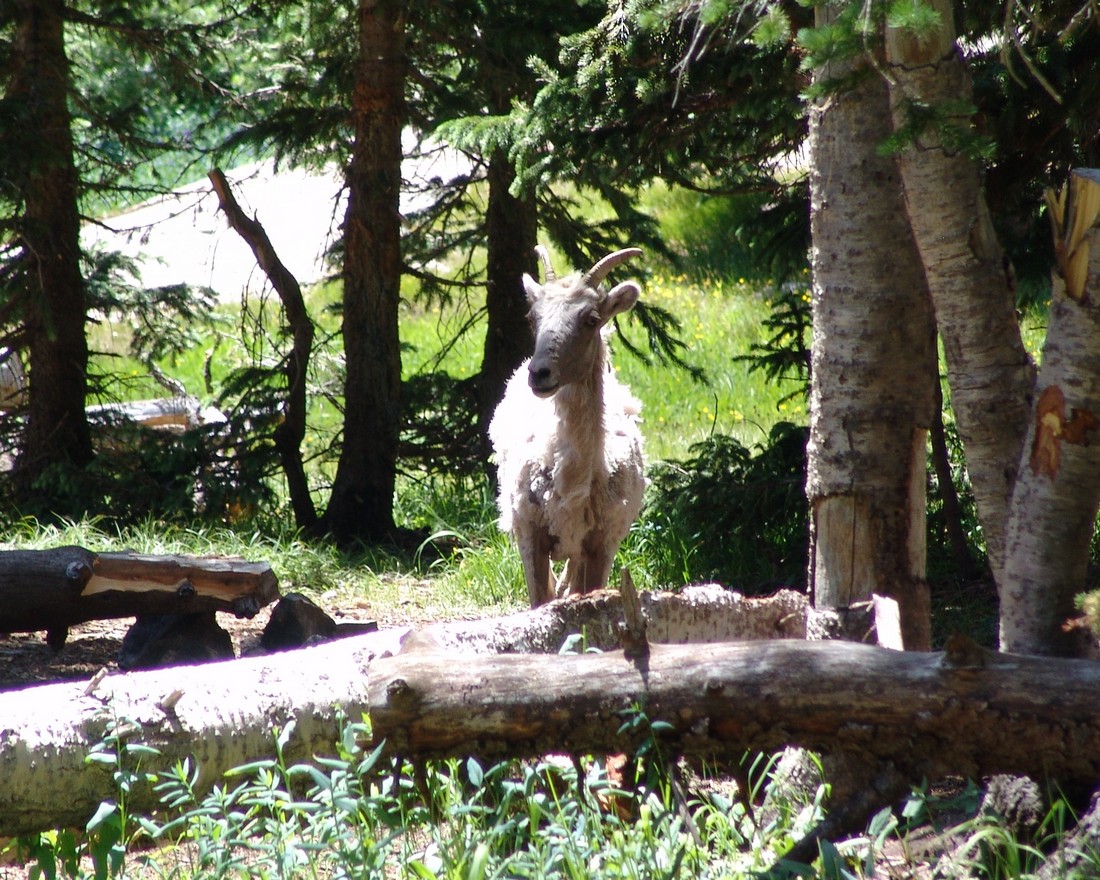
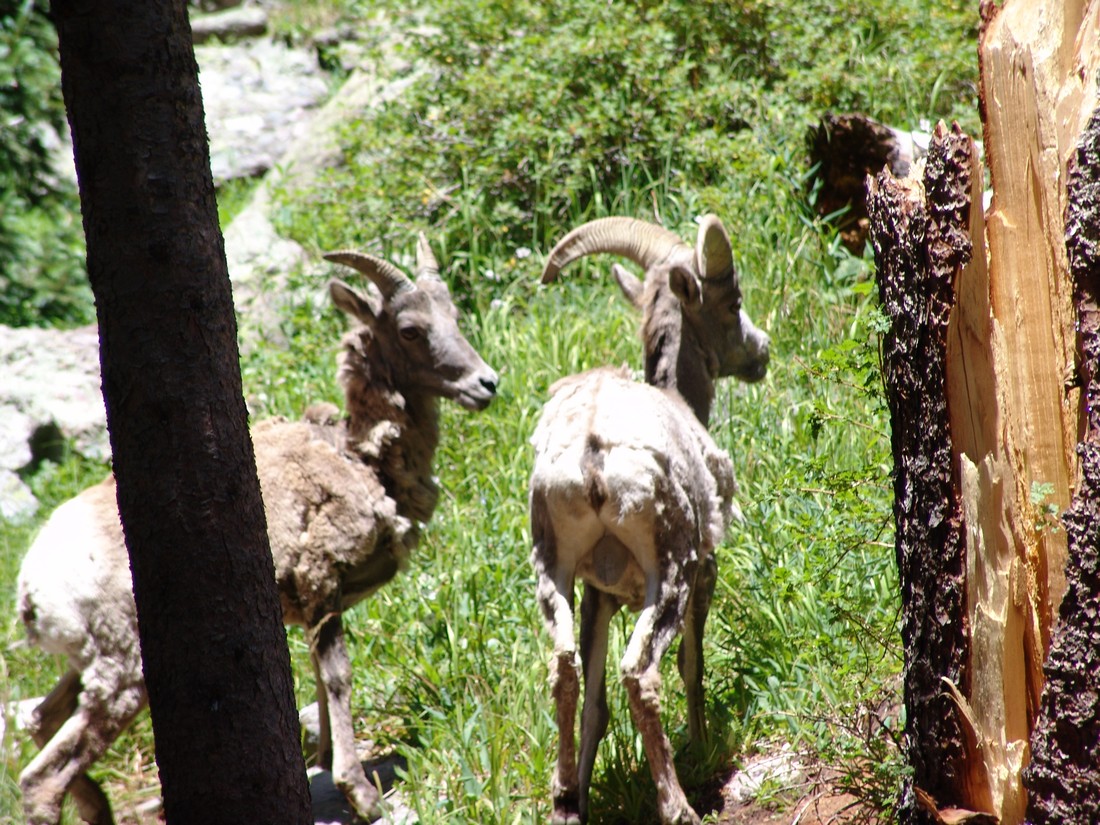
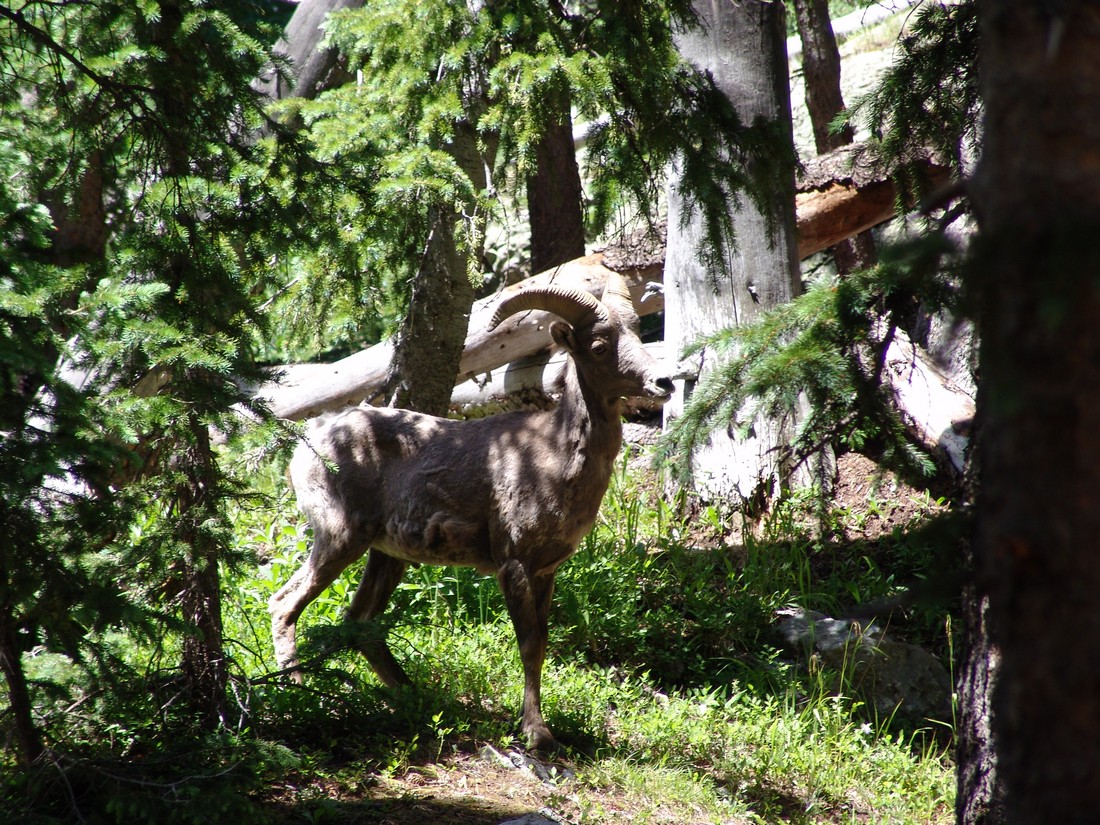
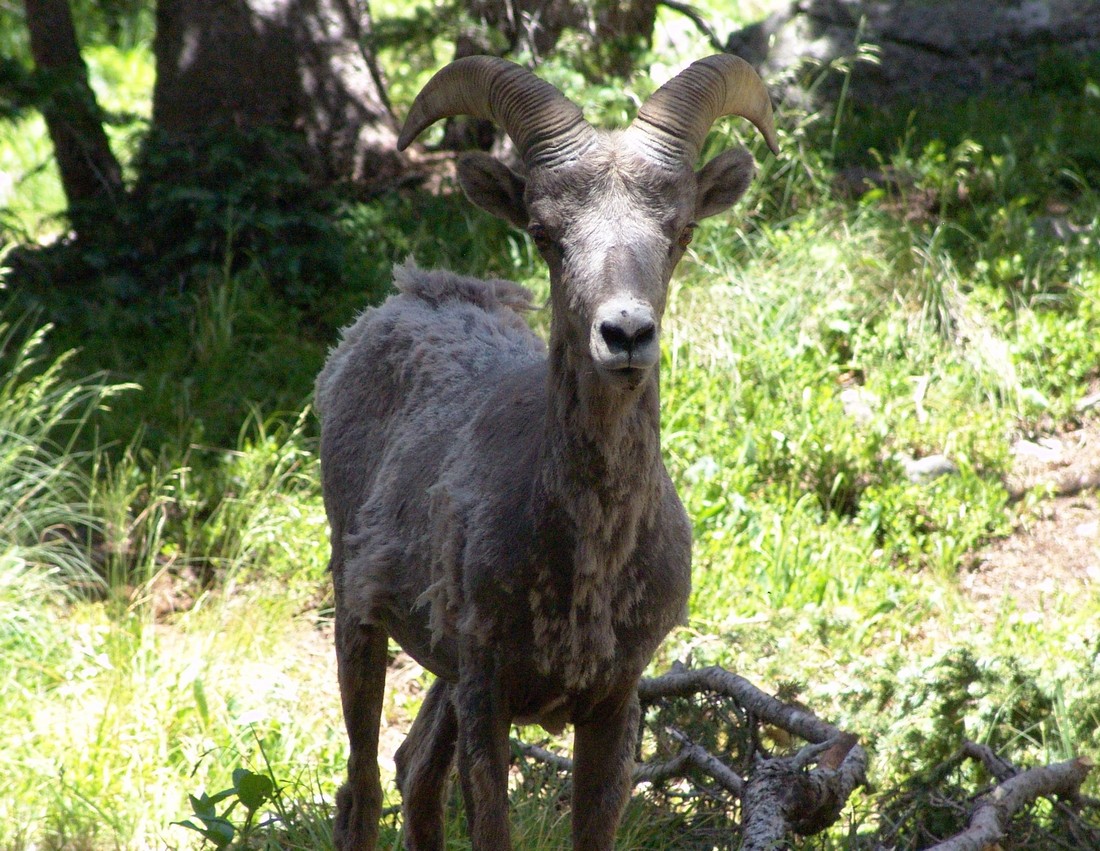
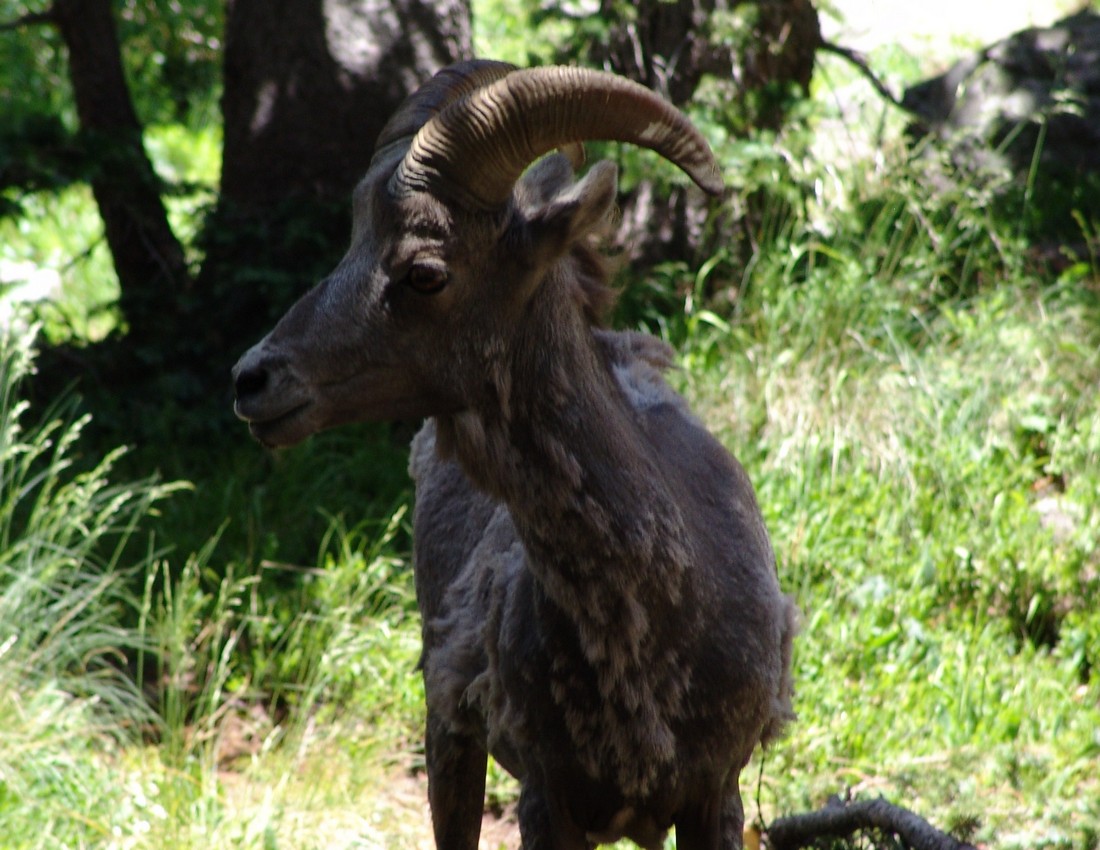
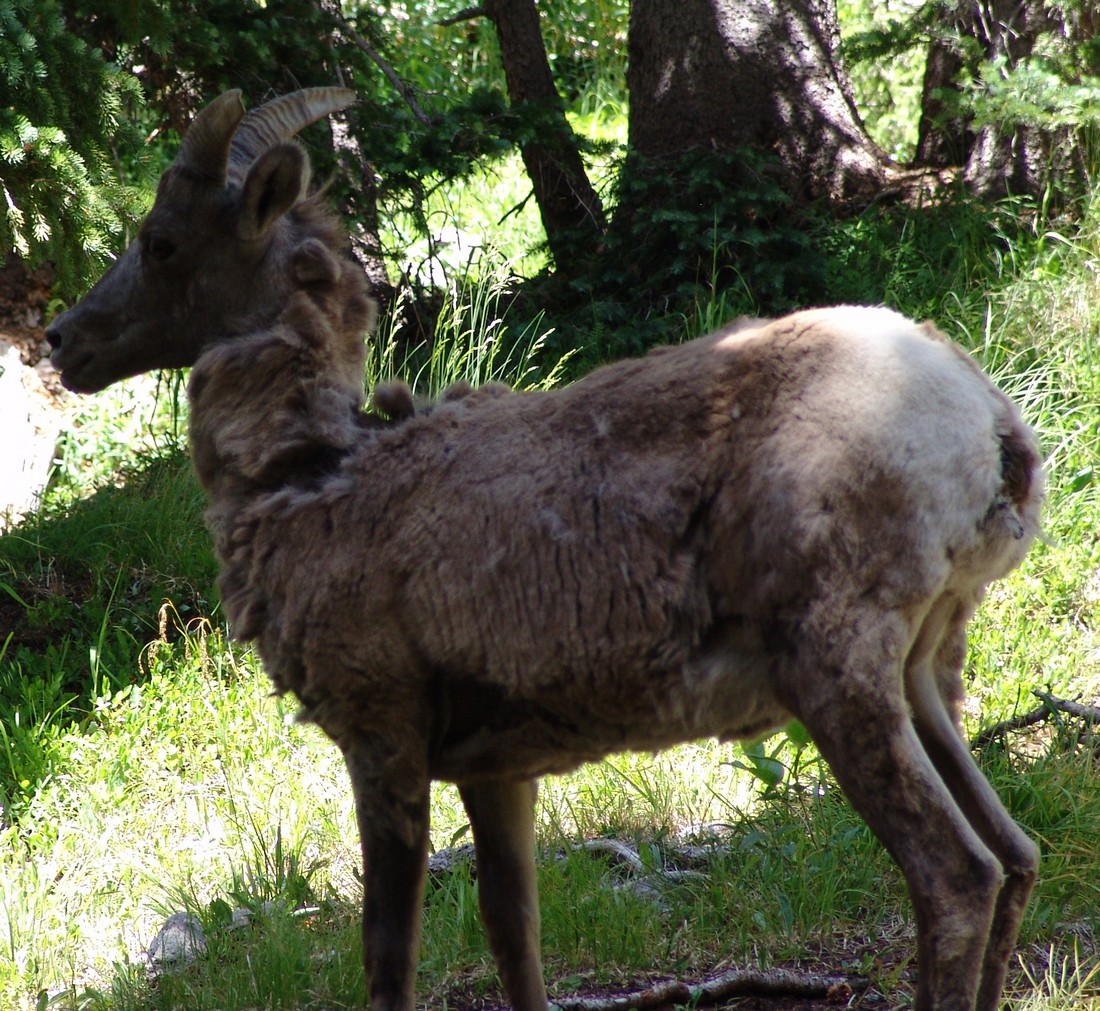
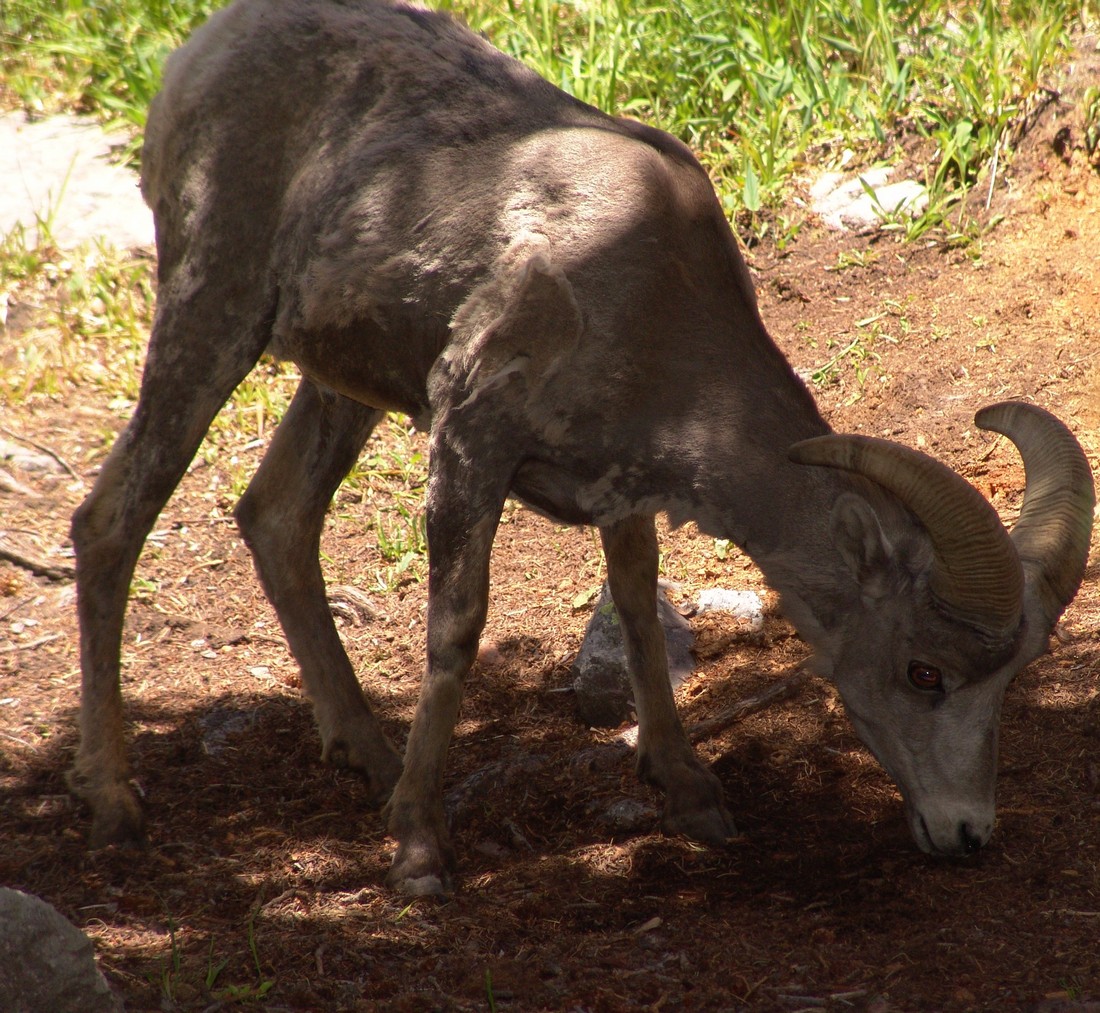
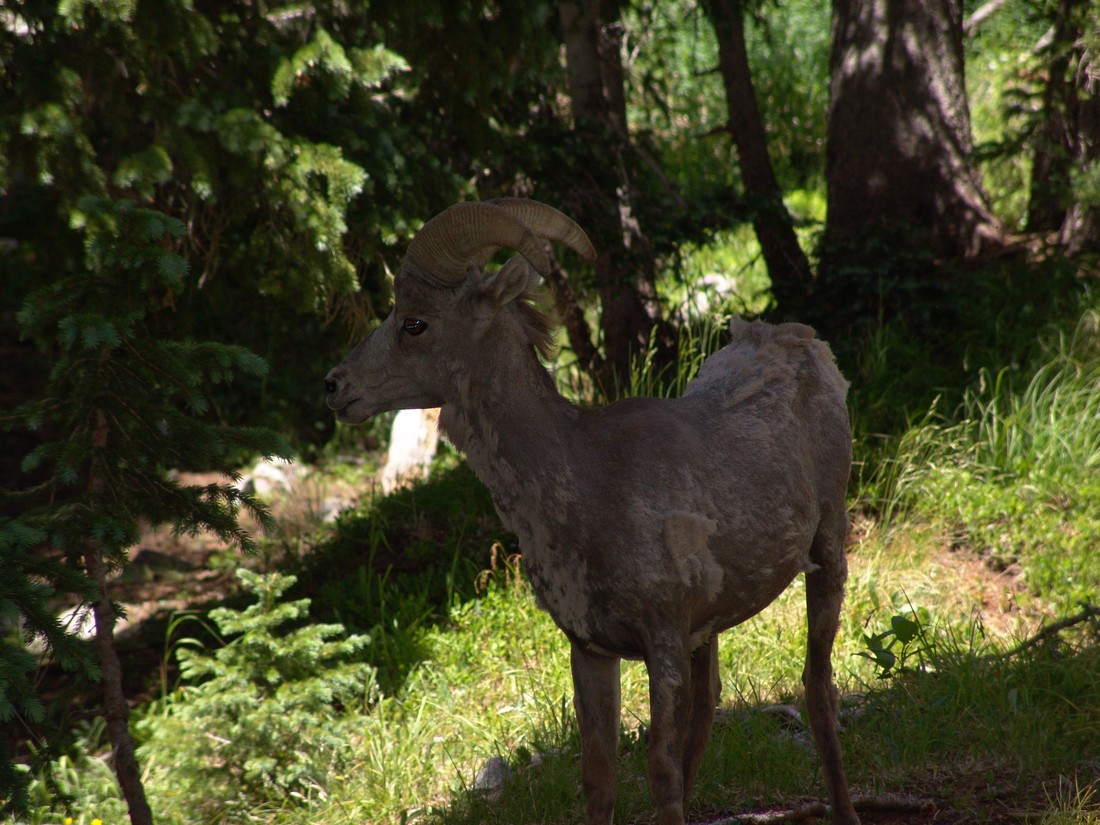
After we were able to chase off the sheep, we set-up camp. The campsite was very nice, with an established fire pit and logs all around it for seating. Here is the view we had of Challenger Point’s north face:
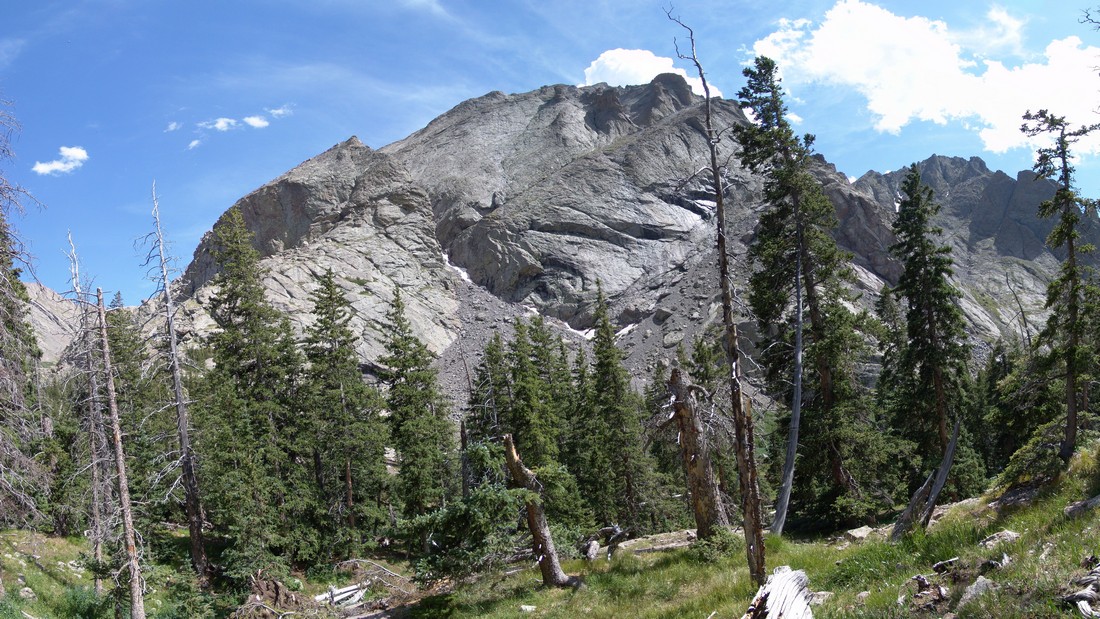
After setting-up camp, we decided to head up the lake to see what it was like. Boy, were we in for a scenic treat! The lake had a giant waterfall at its head and was surrounded by small cliffs where the waterfall was at. Here’s some stitched panoramic photos from the lake: 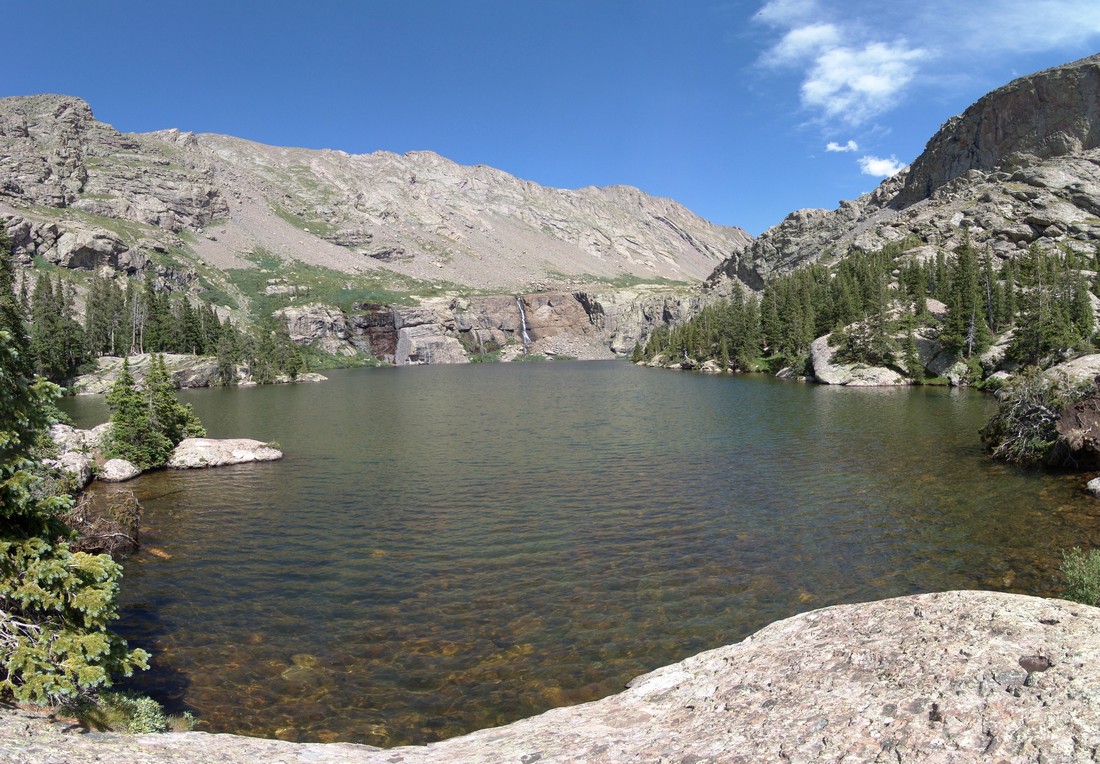

After soaking in as much of the lake as we could, we decided to head back to camp, cook dinner, and call it a night. We woke up at 4 AM the next day and quickly readied ourselves for what was going to be a very long but rewarding day.
We hiked up past the lake and began up the valley to the south. Quickly Kit Carson and Challenger came into view (left and right respectively):
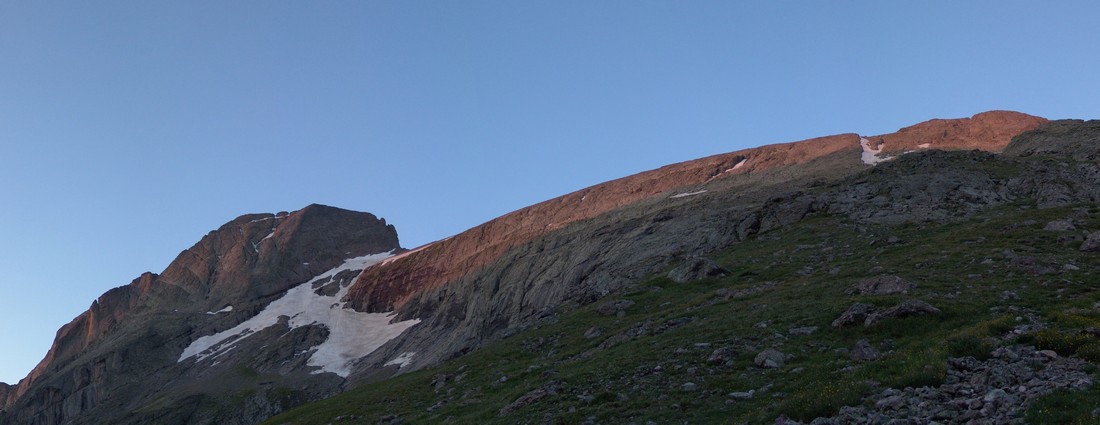
I think Kit Carson looks like a Klingon’s forehead. Who’s with me?

I originally thought that this was “The Prow,” a semi-famous section of Kit Carson that is a a notorious rock-climbing route; however, it turns out that “The Prow” is on the other side of Kit Carson and is seen from Columbia Point.
Another view looking up the valley at Kit Carson (right) and the adjoining ridge to its South and East.
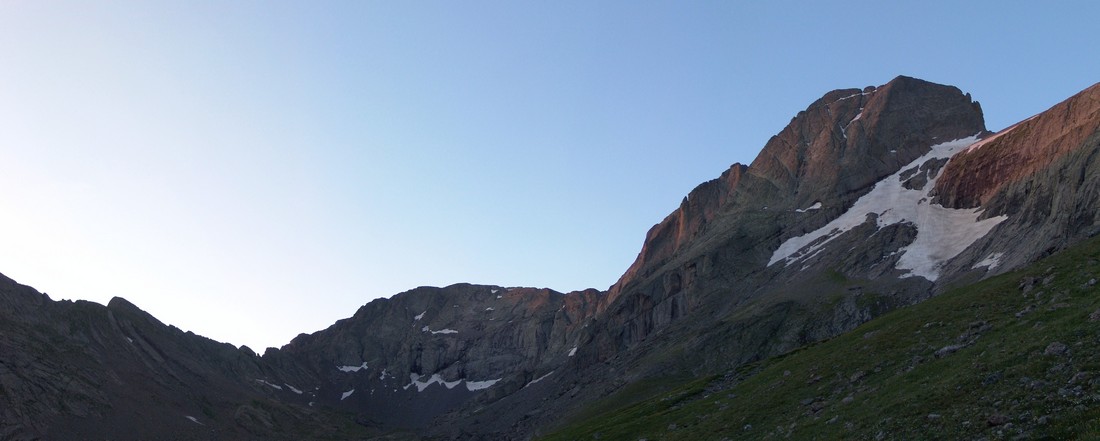
We climbed up the grassy slopes of Challenger Point and then up a loose talus section to the ridge. From the ridge we could see the top of Challenger Point and looking down we could see the upper Willow Lake and the sun’s reflection on it.

We started climbing up the ridge to the southeast towards Challenger Point. Here is a view from near the summit of what the ridge climbing looked like. 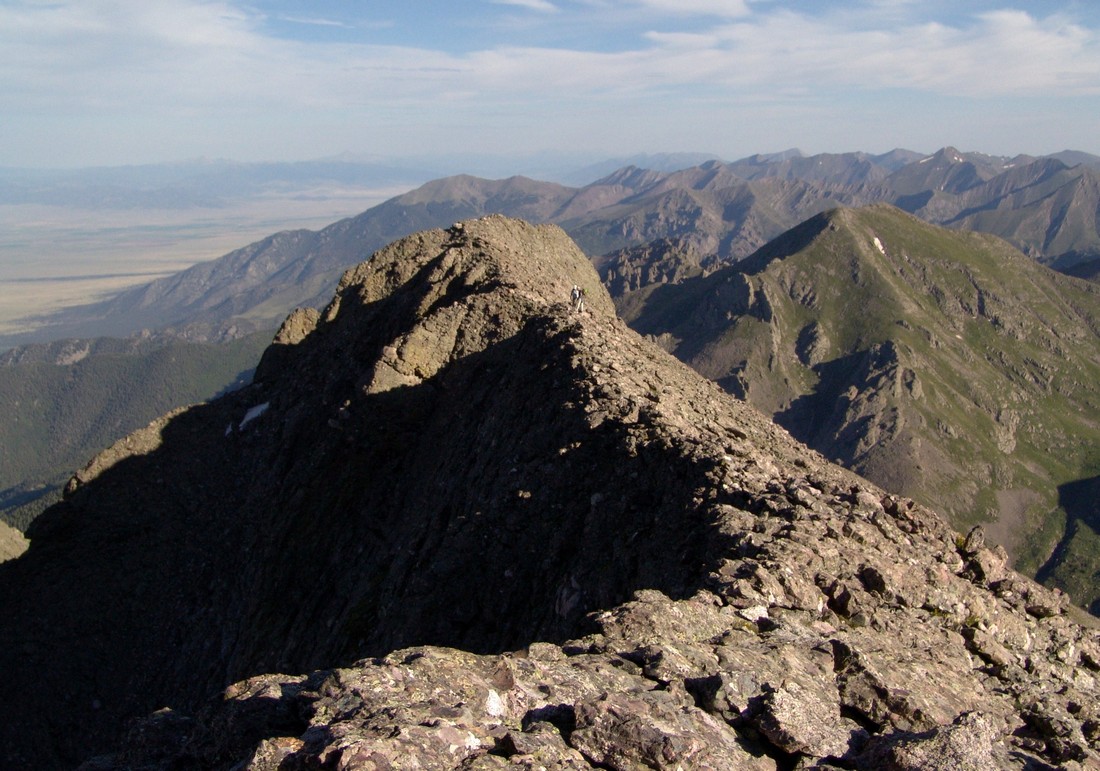
A few minutes later and we arrived on top, with Kit Carson and Crestone Peak in full view and the Blanca group in the distance to the South. 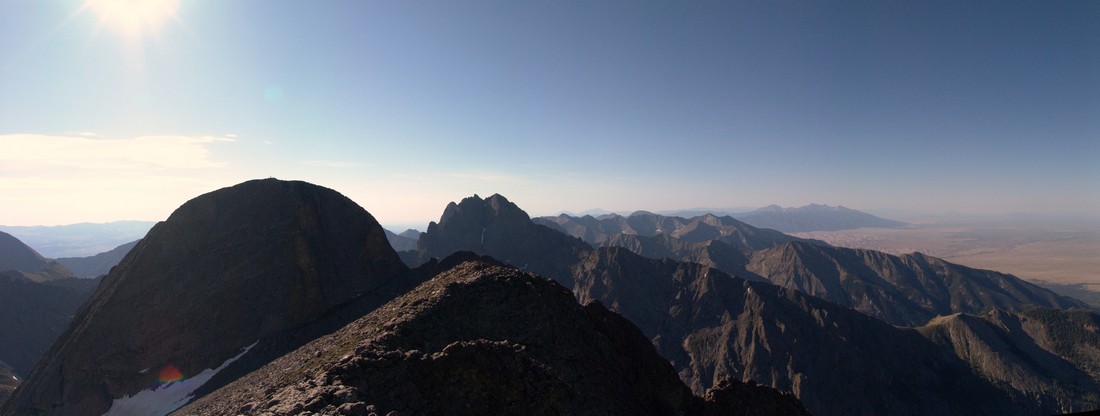
Looking east we could see Mount Adams poking up towards the sky. 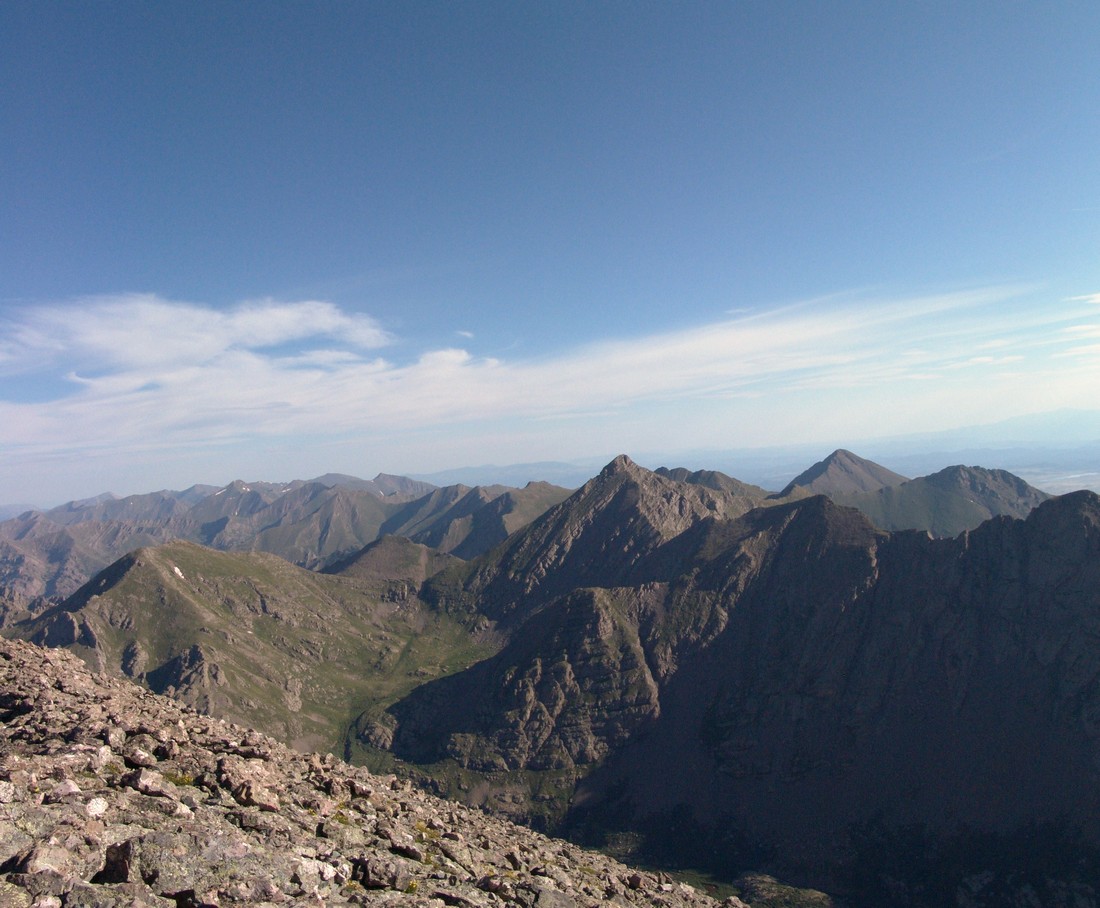
And here’s a shot of me on the summit looking southeast towards Crestone Peak and Kit Carson: 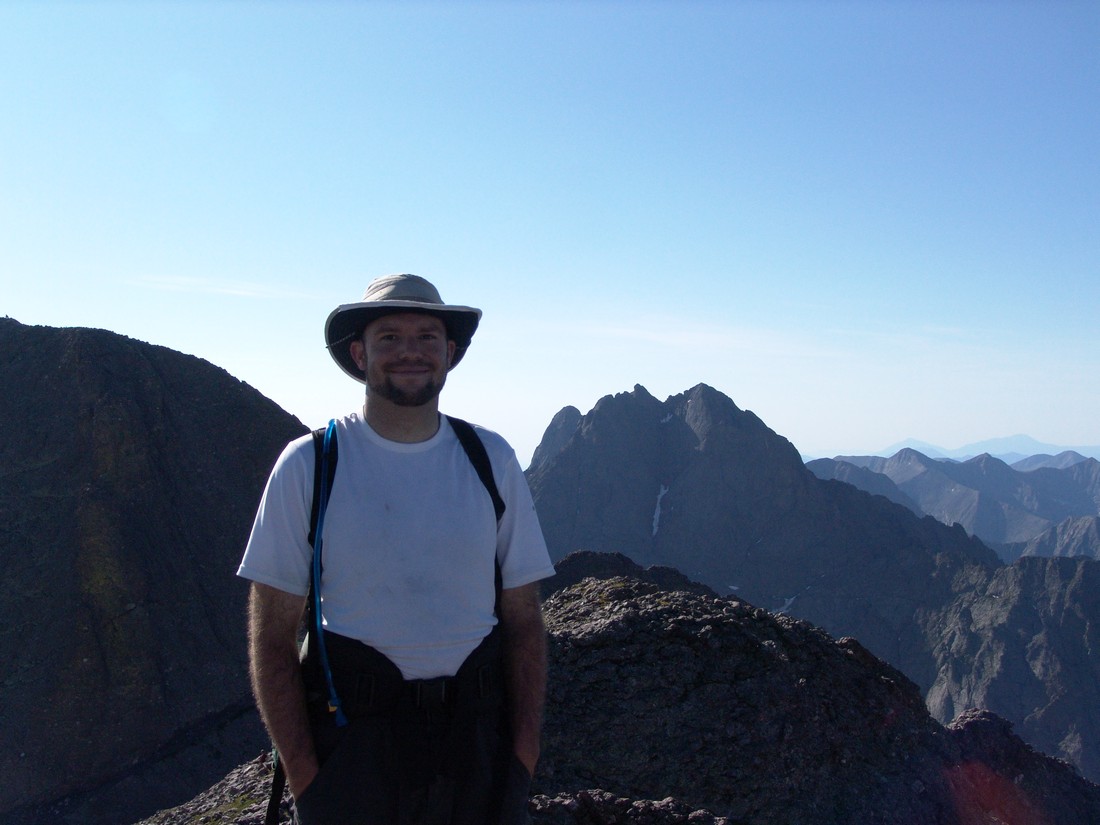
On top of Challenger Point rests a plaque dedicating the mountain to the Challenger shuttle disaster of 1986. 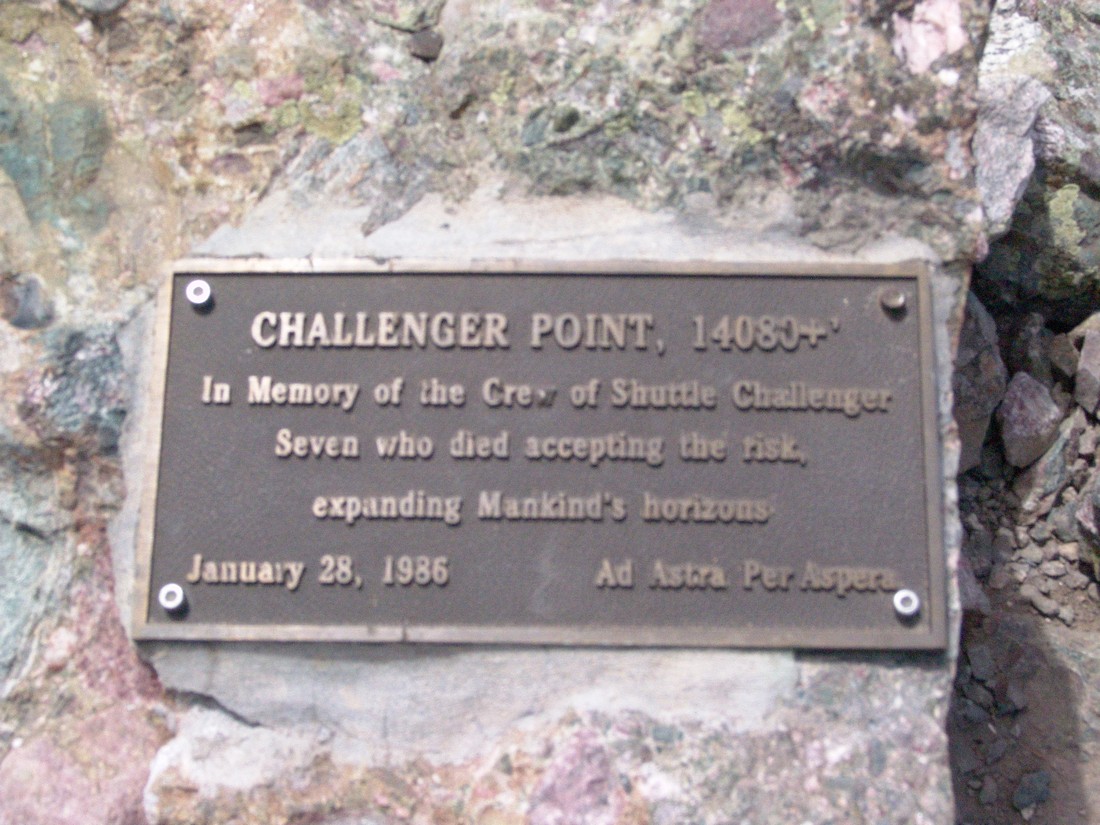
After refueling on top of Challenger Point, we began the journey down Challenger Point’s southeast ridge towards Kit Carson and the Kit Carson Avenue, a long ledge leading around the side and then around the back of Kit Carson. Here’s a look at some of the perilous cliffs below Kit Carson Avenue and subsequently, a photo of the Avenue and the route up it. 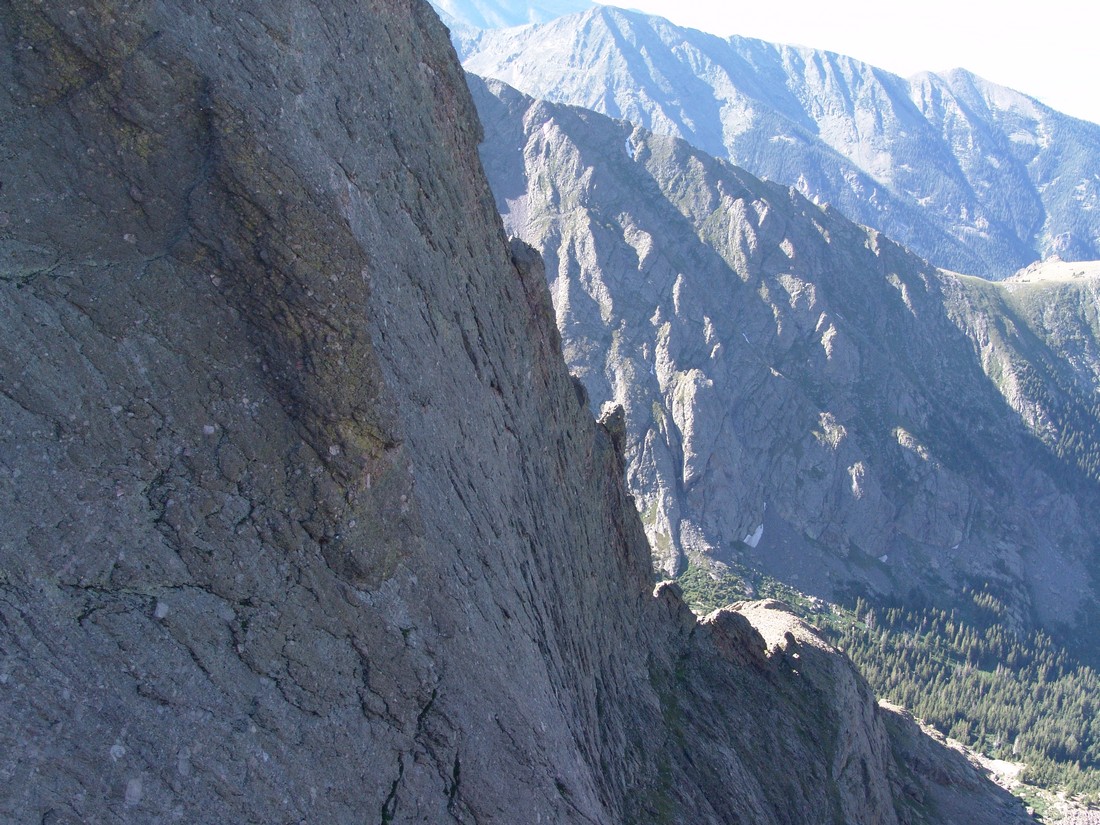
The Avenue looks pretty sketchy from here but in reality it was a nice ledge with plenty of room for walking. Once at the top of the Avenue, you once again can see the awesome Crestone Peak (center) and Columbia Point (left) with the back-side and downward heading remainder of Kit Carson Avenue. 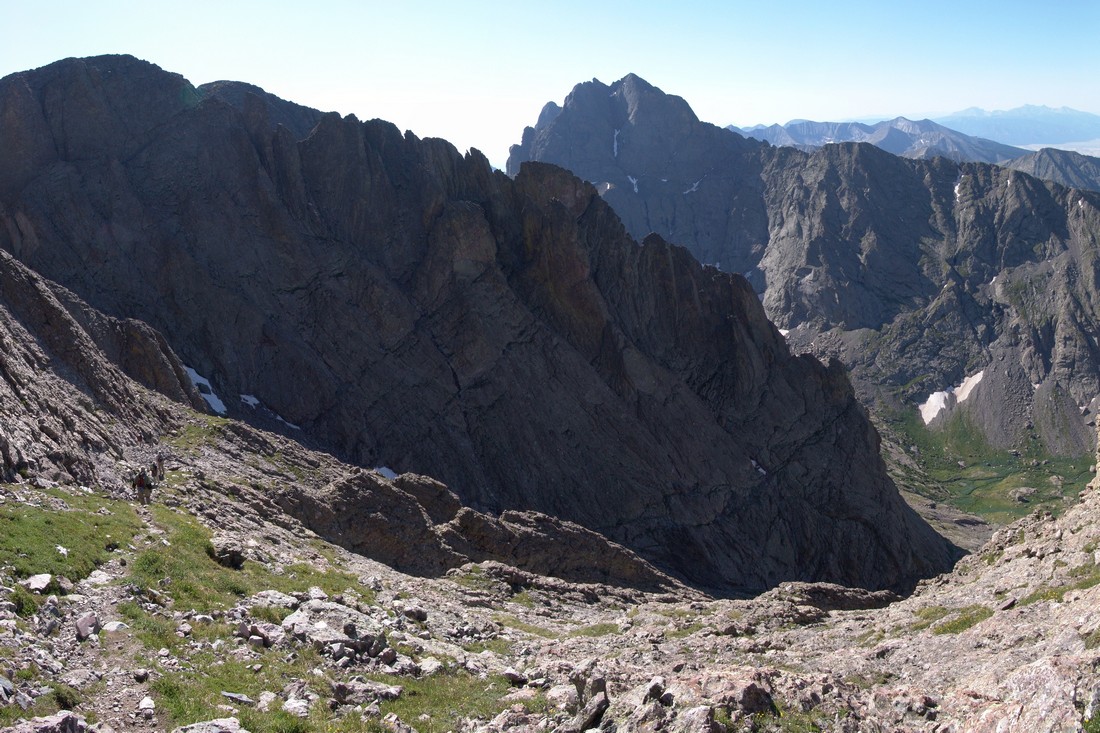
Going down the Avenue, I was struck by the really remarkable geological formations. It appeared to me that water had eroded the underside of Kit Carson in the Avenue, making it look like something had burrowed its way right through the rock all the way down.
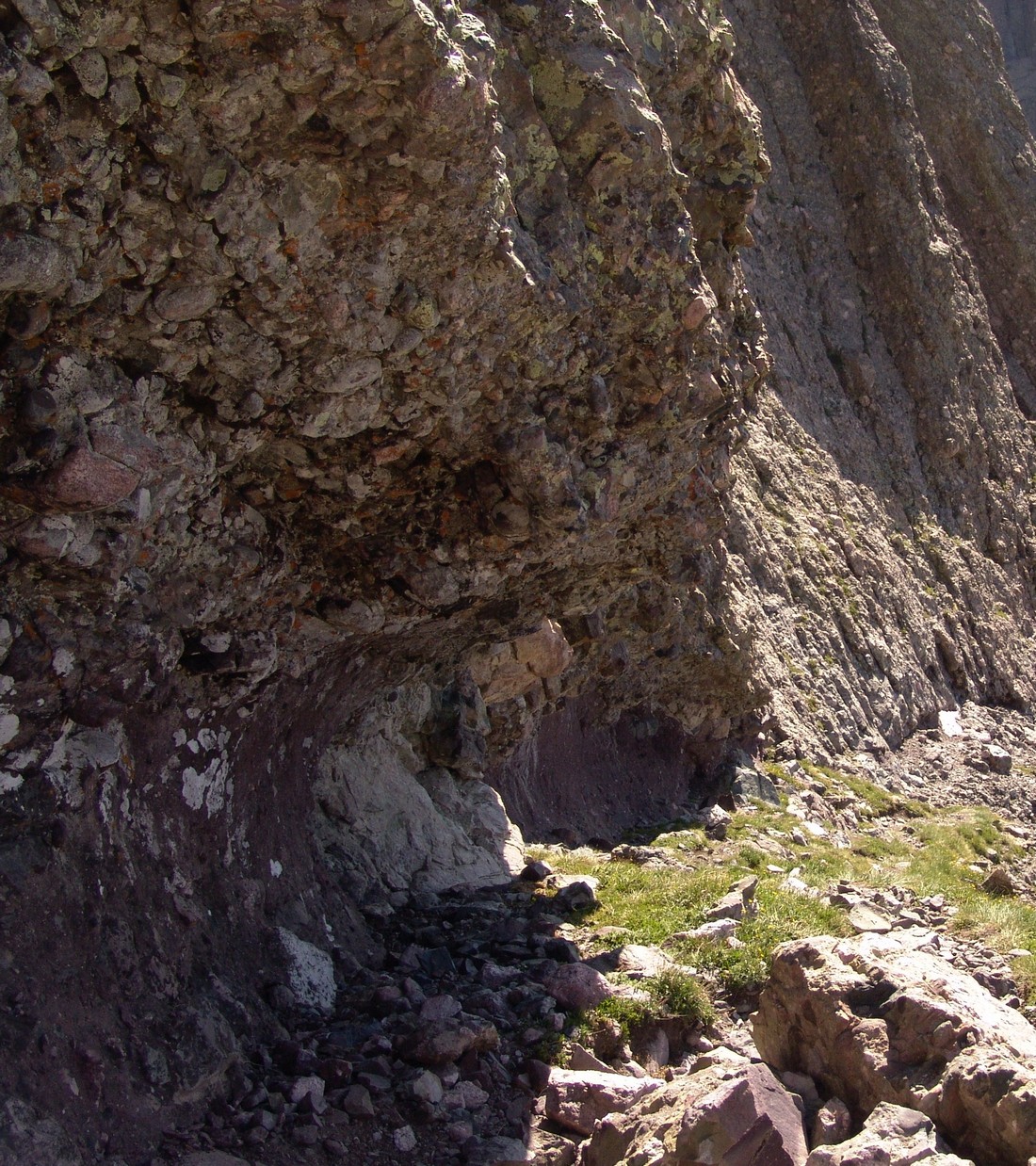
And another view looking down the Avenue – it looks far less intimidating than it did from the top of Crestone Peak. 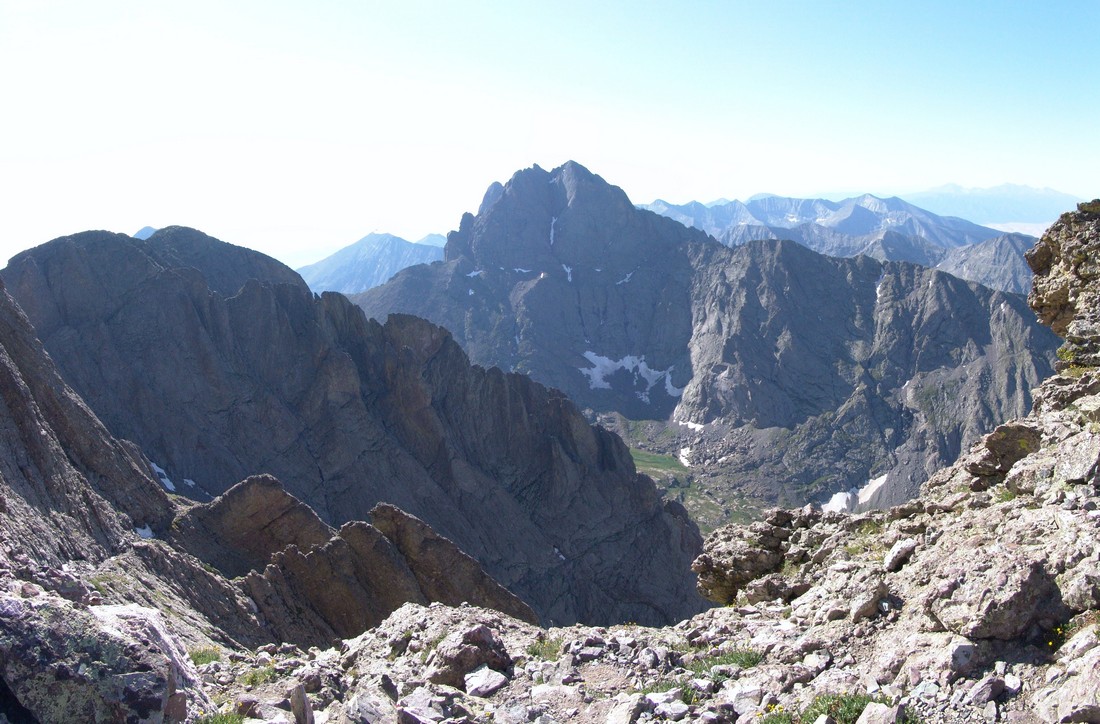
Once we reached the bottom of the Avenue, the route took us sharply to the northwest. The climbing was pretty standard class 2 stuff. Near the top of this last section Terry ran out of gas and took a break to rest. I decided to make the final push to the top after visually verifying that Terry was not injured and was continuing. Here’s a shot looking towards Columbia Point and Crestone Peak again. Take special note on the intimidating nature of Columbia Point (closest peak) from this vantage point, as it was the side of that mountain that I would later climb… Looking at Columbia Point you can see a small fin that is separated from the mountain by a small gap. That is the fin I would later ascend to reach the top (more later). 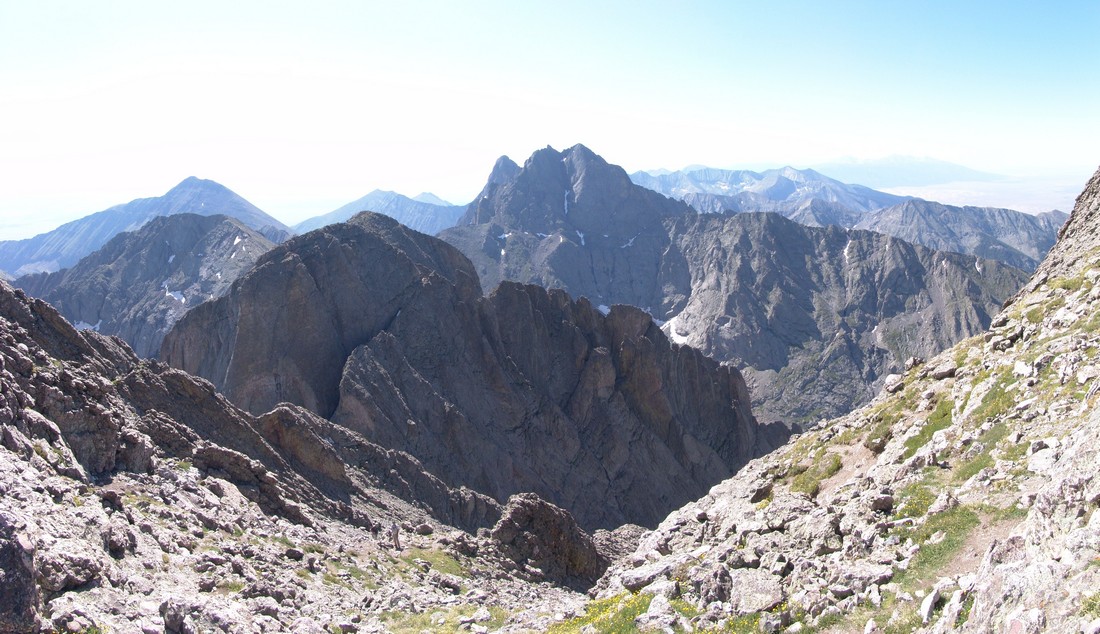
From here, reaching the top of Kit Carson was a breeze. There were several other groups on top. Here’s some stitched photos looking towards Challenger Point. This is a good view of the route we had to come up earlier in the day. Basically starting from the large lake pictured right of center, you climb up the grassy section and then up the rocks to the ridge. 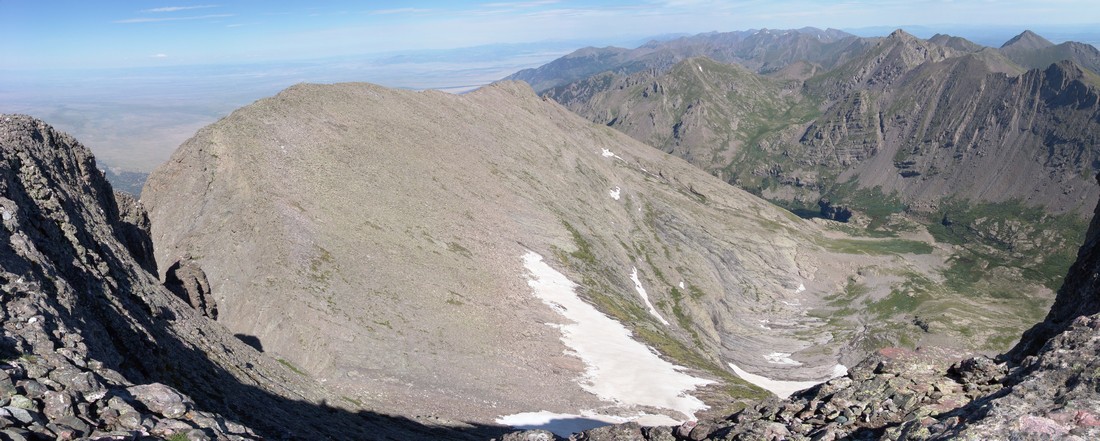
Speaking of the lake, here’s a really high-detail pano of it.
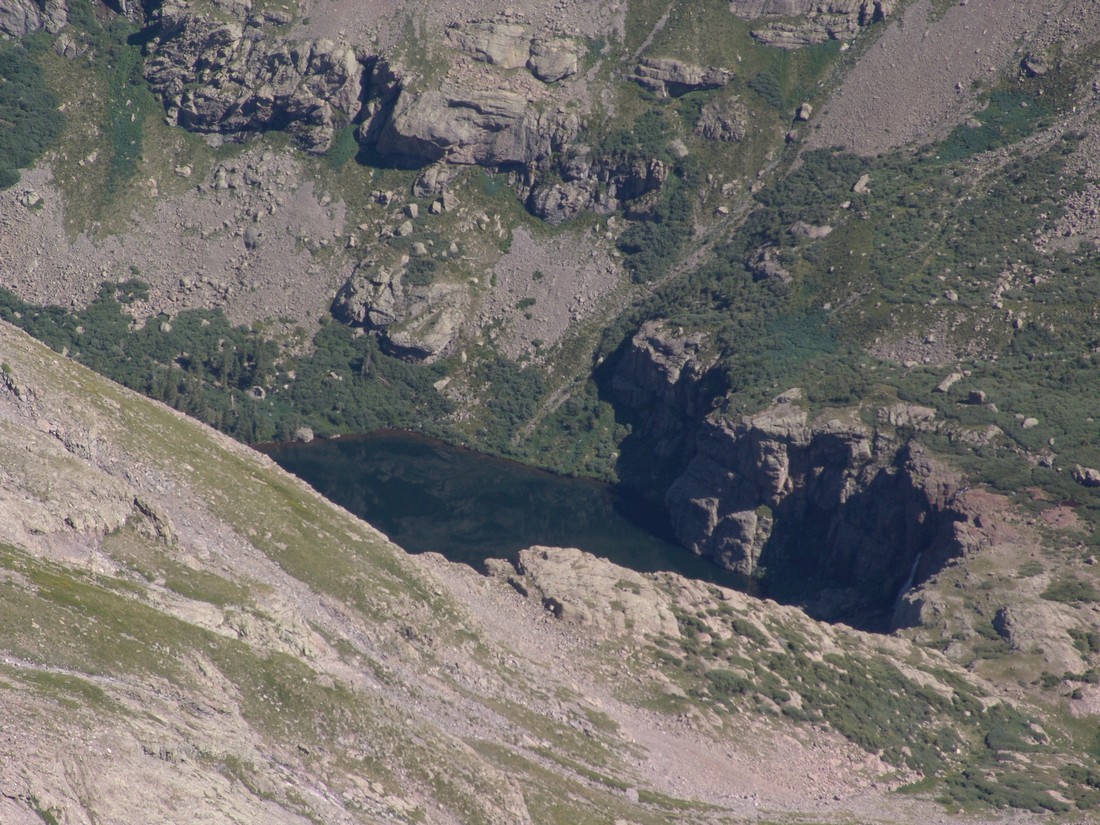
And a shot looking south. 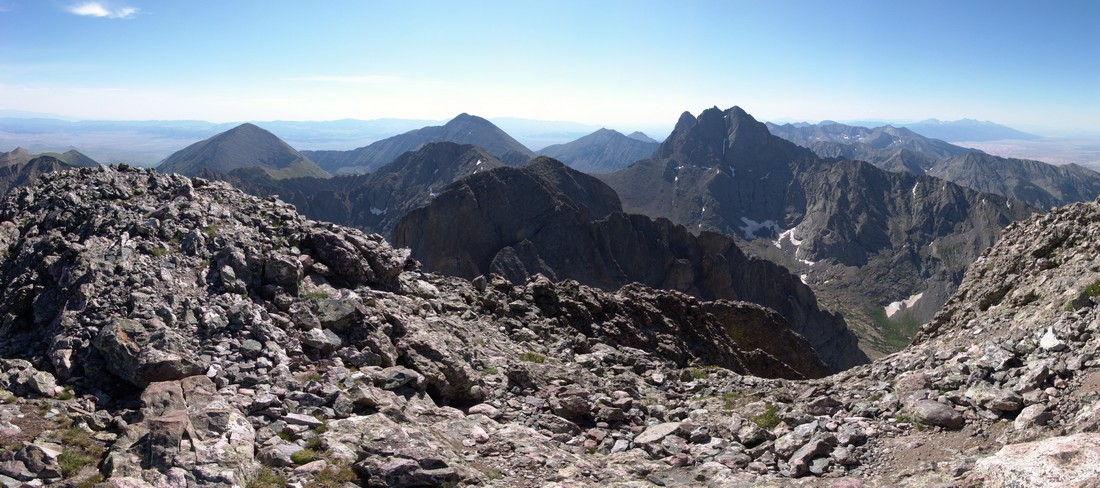
And a 180 degree pano with Columbia Point in center. 
And of course here I am flexing victoriously on the summit. 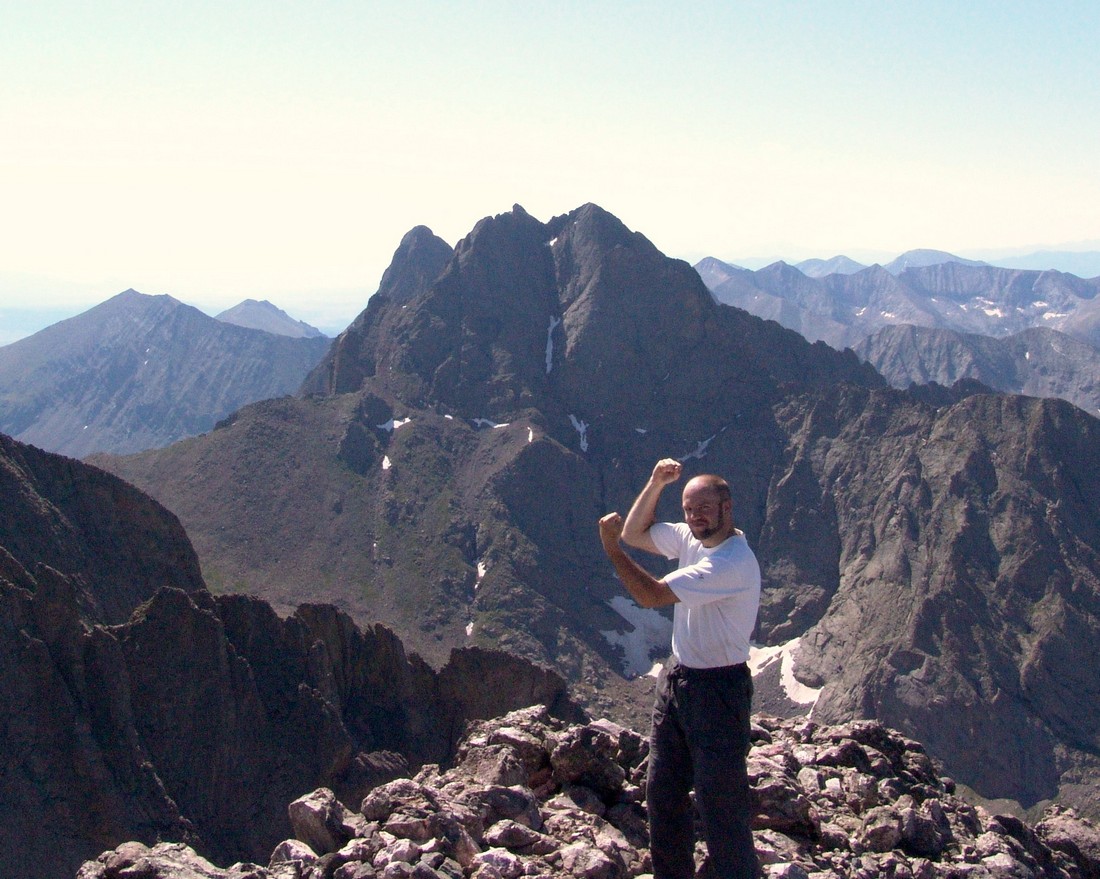
After a quick snack on top I decided it was time to go back down and decide if I was going to climb Columbia Point. Terry had already headed down and would not be attempting Columbia Point. After running into another climber on the way down and picking his brain on the approach for Columbia Point and assessing the weather, I decided to give it a shot solo. This was possibly the most technically challenging climbs I’ve done to date. The route was not well-established and there was a couple of spots where I was exposed and could have fallen to my demise. Here’s a picture outlining my rough route up. 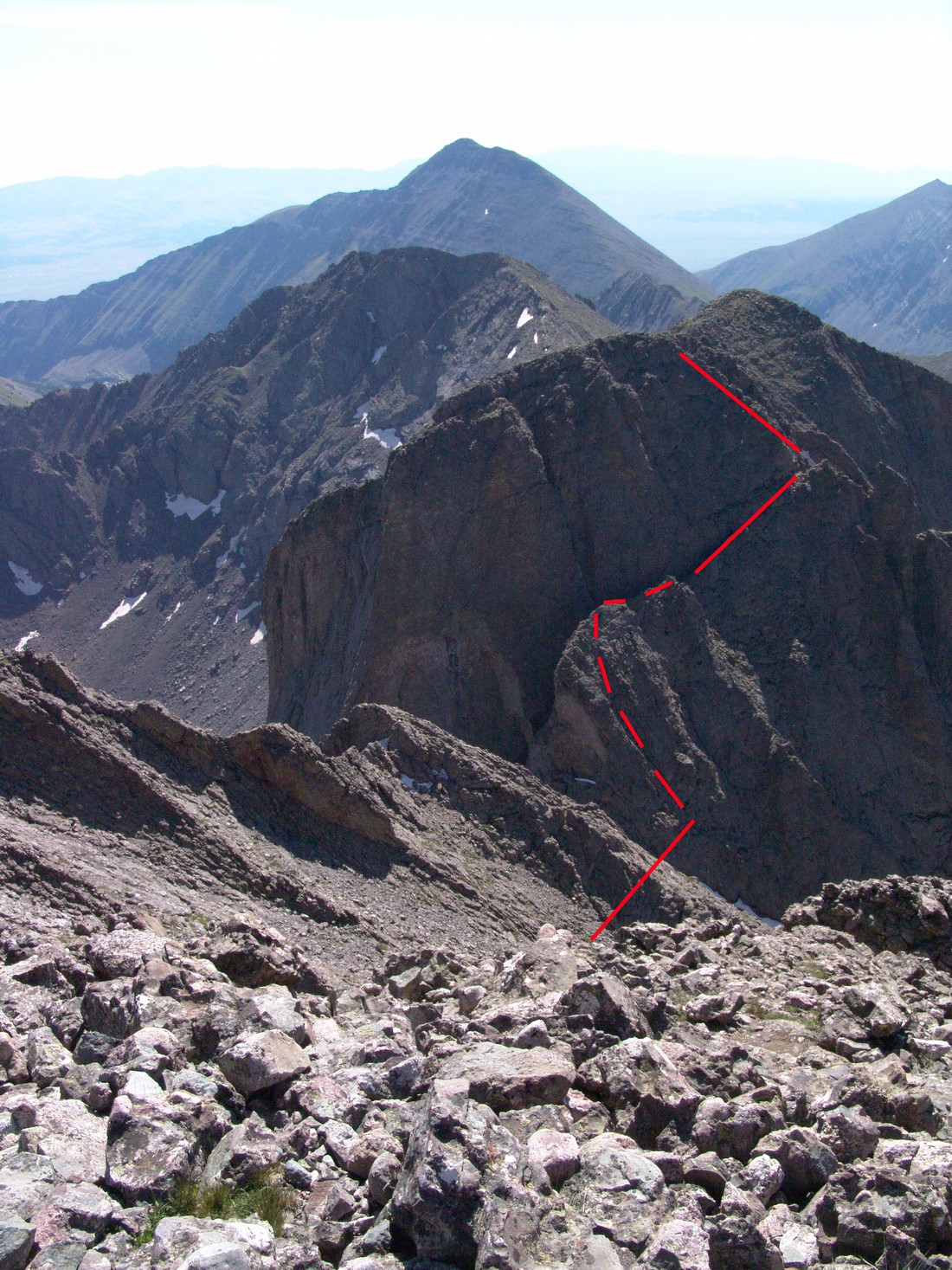
Once I reached the top of the first gully of the fin (5th red line from bottom), I had to make a really risky move to down-climb about 10 feet to the next section of the fin. I sat there for at least two minutes and contemplated the move’s risk and thought of turning around. I would definitely rate the move as Class 5 (Class 5: Technical free climbing involving rope, belaying, and other protection hardware for safety. Un-roped falls can result in severe injury or death) as it was 100% vertical and required both hand holds and footholds. Even though I still had on my backpack and had my camera around my neck, I decided that I had the skills and the mental acuity to give it a shot. This move was really tricky as I had to somehow flip myself around and onto the face of the rock wall, with 300 feet of exposure (Empty space below a climber, usually referring to a great distance above the deck through which the climber could fall) to the left and a steep rocky slope below me to the right. I took a photo of the spot but it really does not do it any justice. Perspective is everything. I was amazingly cool during the attempt but did find myself shaking a little and my heart was racing pretty fast. Once I secured myself onto the face of the wall, I descended several feet down, ensuring that my hands and feet had secure holds with each move. In retrospect, this was a very risky move and leaving the gully earlier to avoid it would have been prudent. After this, the route was pretty straight forward up the fin and then up the steep ridge. It was hand over hand the rest of the way up. I reached the top and took photos of the mountains surrounding me; Crestone Needle, Crestone Peak, and Kit Carson. 
At this point, “The Prow” of Kit Carson was readily apparent to the left of Kit Carson’s summit.
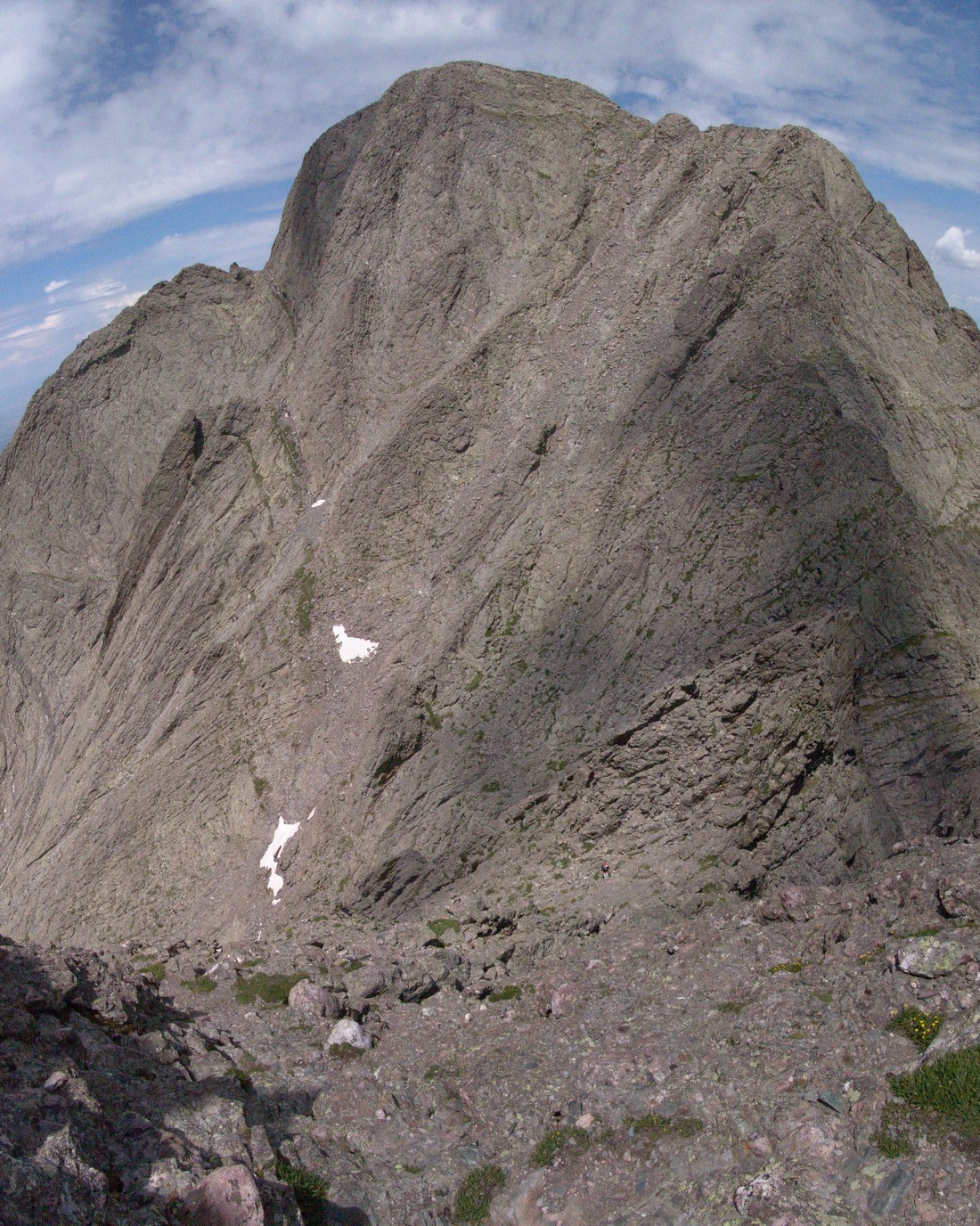
After taking pictures I took some time to search for something I had heard about… I was unable to locate a plaque that was dedicated to the Columbia shuttle disaster of 2003 as seen here:

This was a real disappointment because it was one of the reasons I wanted to climb this mountain. I searched around the summit in all directions but could not find it. Frustrated, I second-guessed that I was truly on the summit of Columbia Point and not “Kitty Kat Carson,” an unranked 13’er right next to Columbia Point to the south. You can see it behind Columbia Point in the photo above. Even though a summit register on top said I was on Columbia Point, I wanted to go over to the other summit to be sure. After a quick trip over to “Kitty Kat Carson,” I determined that I was indeed on Columbia Point previously; however, the trip was well worth it as I was able to get some pictures of the full-on and un-obscured view of Crestone Needle and Crestone Peak.
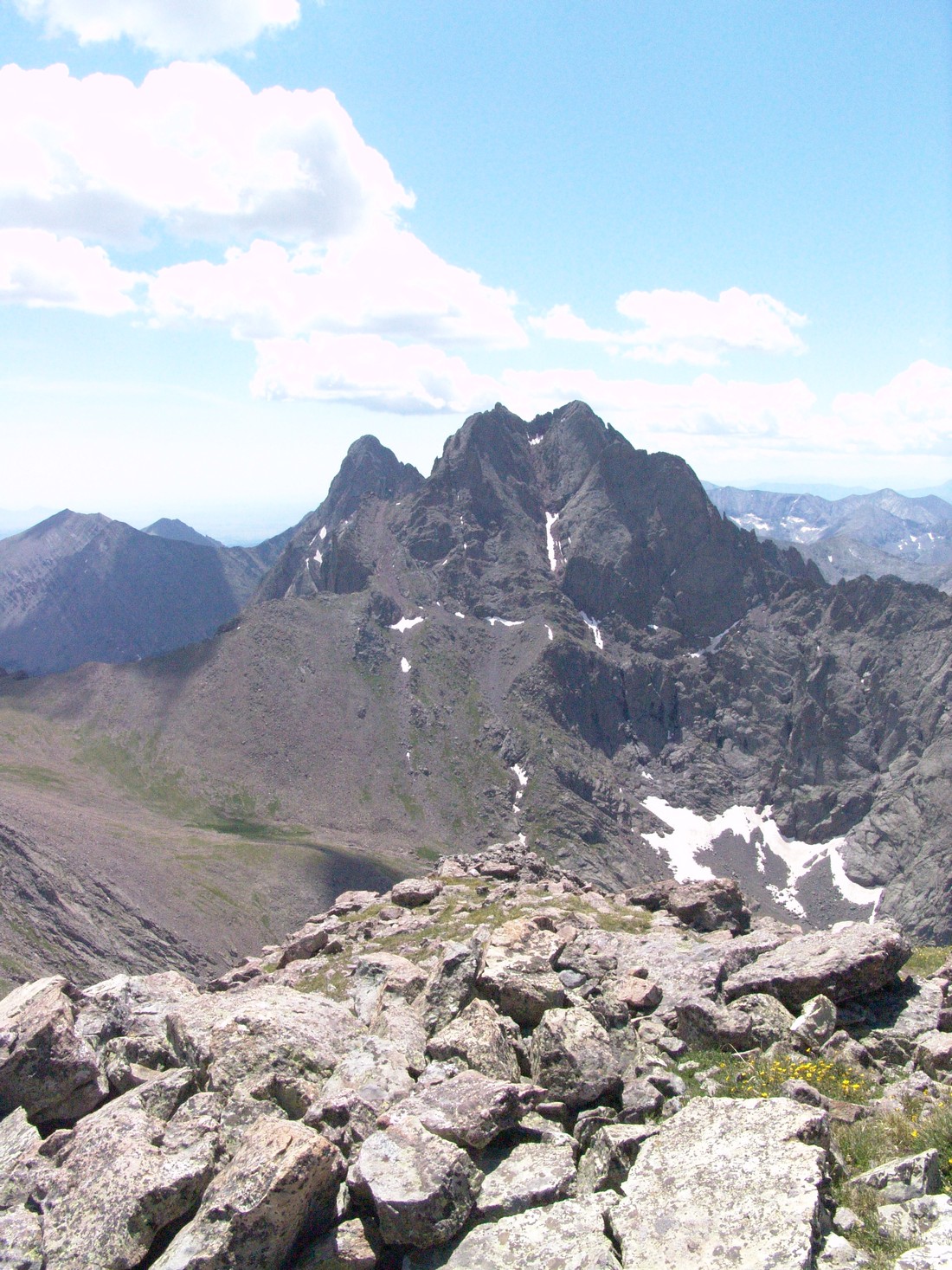
After enjoying the views from “Kitty Kat Carson,” I decided to go BACK over to Columbia Point one more time to try to find the plaque. Unfortunately I was not able to find it. Looking east, I noticed that some clouds were building so I decided it was time to head back towards Kit Carson and back up the Kit Carson Avenue. Another look back towards Kit Carson revealed that another climber was coming up Columbia Point so I knew I needed to be careful not to kick any rocks down on him.
I reached the top of the Outward Bound Couloir between Kit Carson and Columbia Point and headed back over towards Kit Carson Avenue by way of a steep gully with a large rock terraced over it, which created a nice and tight fit back over to the Kit Carson side of the couloir.
After reaching the top of Kit Carson Avenue, I climbed back down to the saddle between Kit Carson and Challenger Point and decided to re-summit Challenger Point as to ensure that the same route we took to get up would be the one used to get down. Once at the top of Challenger Point again, the nasty weather was building and looking more and more ominous.
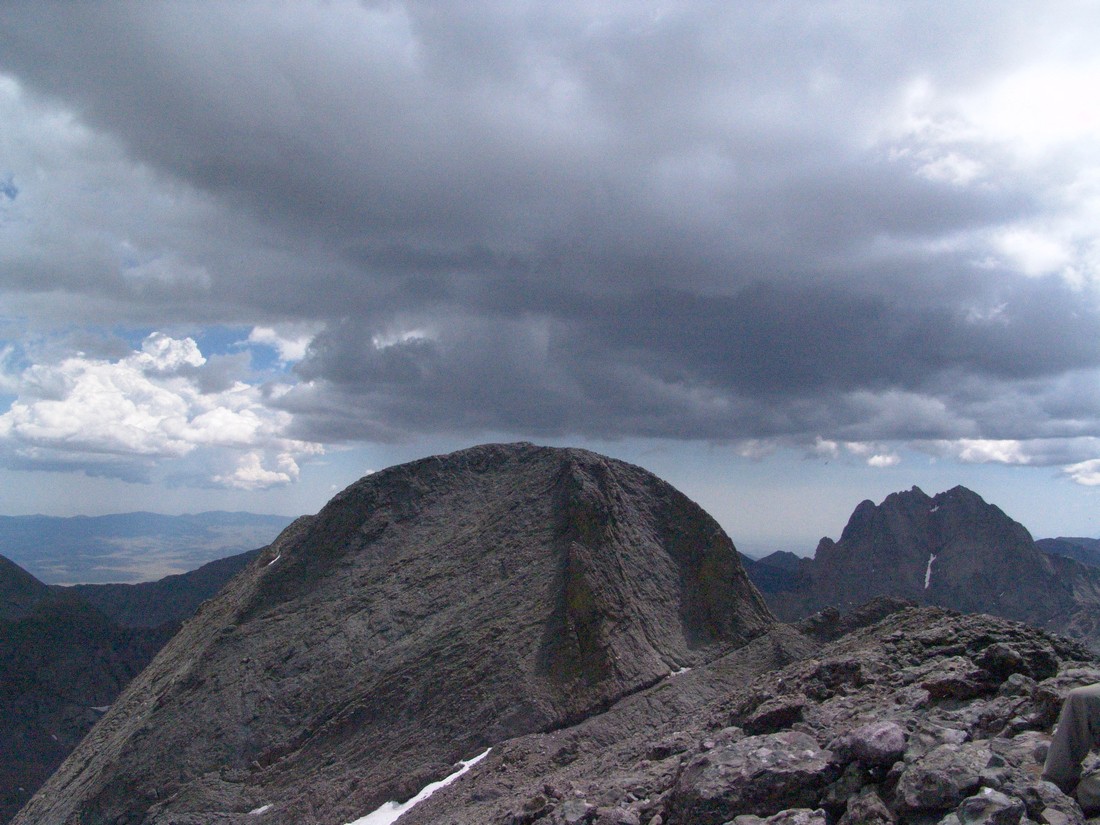
Fortunately the weather cooperated just enough to let us get back down to the lake in our haste. It was pretty cool seeing the flora down there since it was dark earlier in the morning when we were coming up. 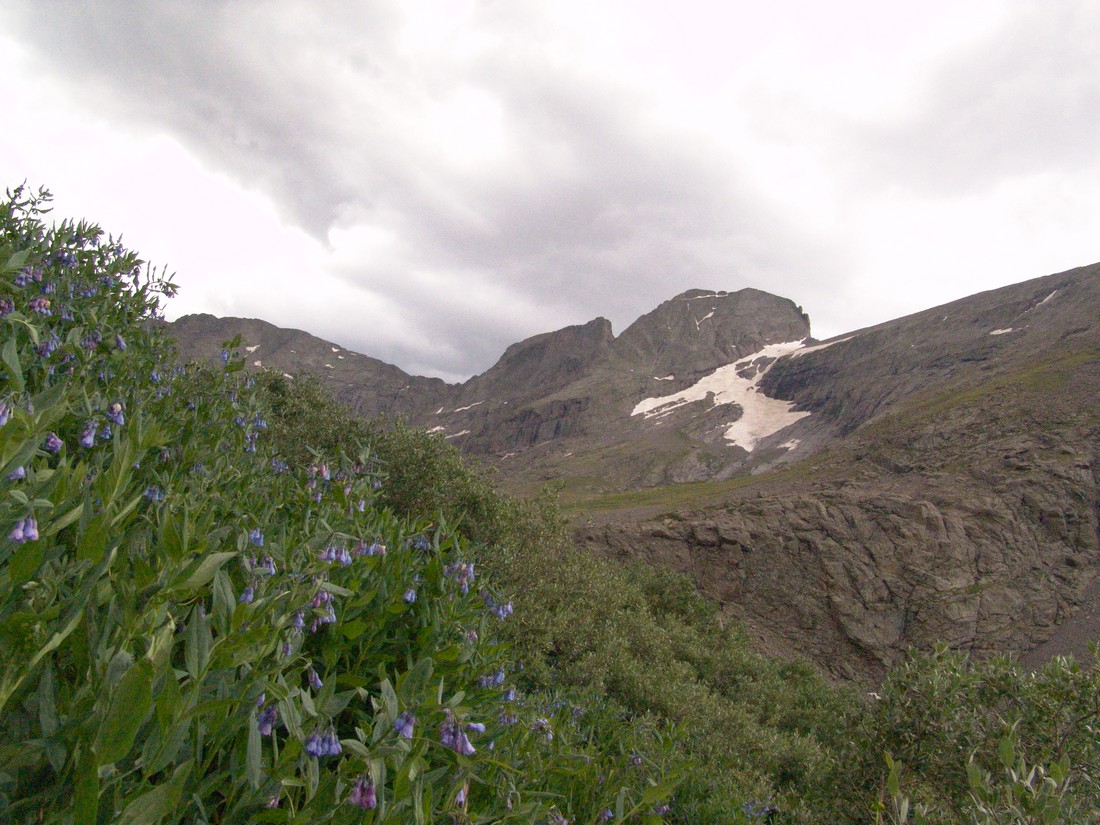
We made it back to camp, packed-up, and headed out. We got back to Colorado Springs at about midnight and I was exhausted.
I would rate this climb highly. It is challenging, offers many routes, and there are several peaks to ascend in the area. All in all, this is a must-do climb for any serious Colorado mountain climber.



